In February 2025, Cathay Pacific deployed one of its retrofitted Boeing 777-300ER aircraft to Singapore, which features the recently-launched Aria Business Class seat, as well as an all-new Premium Economy Class.
These seats are a significant improvement over the previous generation, and will be progressively installed on the airline’s fleet of 30 Boeing 777-300ER aircraft by 2027 (for comparison, Singapore Airlines only expects to debut its new Business Class suite in Q2 2026, with the refit complete by 2030).
Since this aircraft was only rostered to Singapore for a few weeks, I quickly booked my seats as soon as the news broke, redeeming Premium Economy to Hong Kong, and Business Class back to Singapore.
This review is for Cathay Pacific’s new Premium Economy Class seat on the B777-300ER, which I found to be quite impressive on the whole.
| ✈️ tl;dr: Cathay Pacific B777-300ER Premium Economy | |
| Cathay Pacific’s new Premium Economy seat offers a big upgrade in comfort and tech over the previous generation, and rivals should take note. | |
| 👍 The Good | 👎 The Bad |
|
|
How I booked this flight

I redeemed this flight through the Cathay Pacific Asia Miles programme, paying 20,000 Asia miles + HKD$536 (~S$92).
I could have potentially done it for less through Qatar Privilege Club, which would have cost 16,500 Avios + HKD$375 (~S$64; Qatar Privilege Club does not pass on fuel surcharges on Cathay Pacific flights). However, the snag here is that Qatar Privilege Club does not offer online redemptions for Premium Economy awards on Cathay Pacific. I’d need to fill out an online redemption request form, and there was no guarantee the seats would still be available by the time they got back.
Since I didn’t have a lot of flexibility with my travel dates, and the aircraft was on a limited-time deployment to Singapore, I went with the slightly pricier option to lock it in immediately.
Preflight
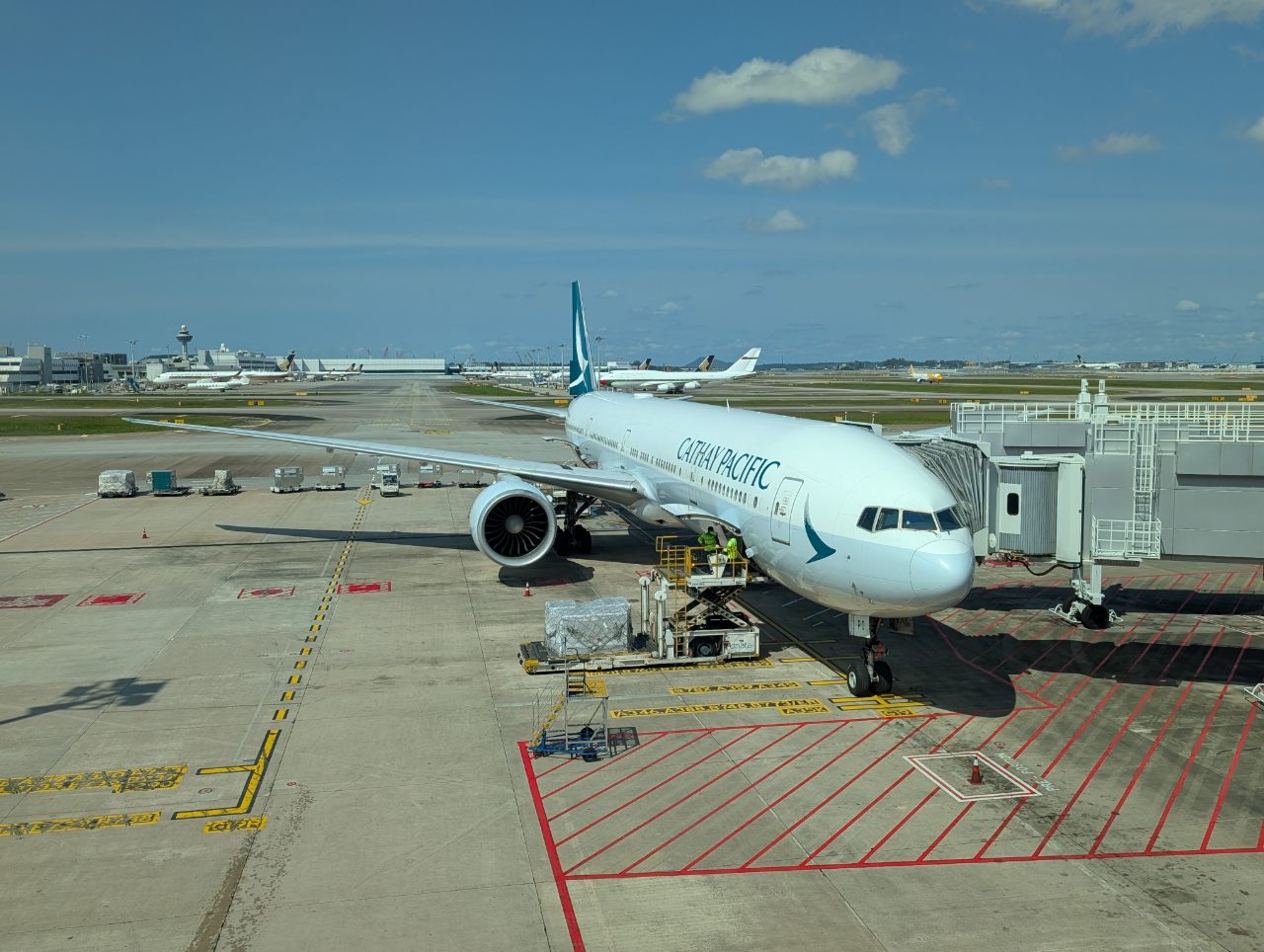
Cathay Pacific operates out of Singapore Changi Airport Terminal 4.
Early check-in is available at Changi Jewel from 10 a.m to 10 p.m daily, and passengers can check-in 3 to 12 hours before departure time. Early check-in can also be done at Cathay’s counters in Terminal 4, though most people will prefer to check-in at Jewel so they can enjoy the mall and Terminals 1/2/3 before making the bus journey to the relative isolation of Terminal 4.
Eligible passengers can visit the Cathay Pacific Lounge at Terminal 4, which I reviewed on a previous trip. This is a very pleasant place to relax and get work done, though it doesn’t offer showers or a bar.
You should leave adequate time to get to your gate, as Cathay Pacific flights always depart from the far end of the terminal from Gates G18-21, the only gates that can accommodate wide-body aircraft.
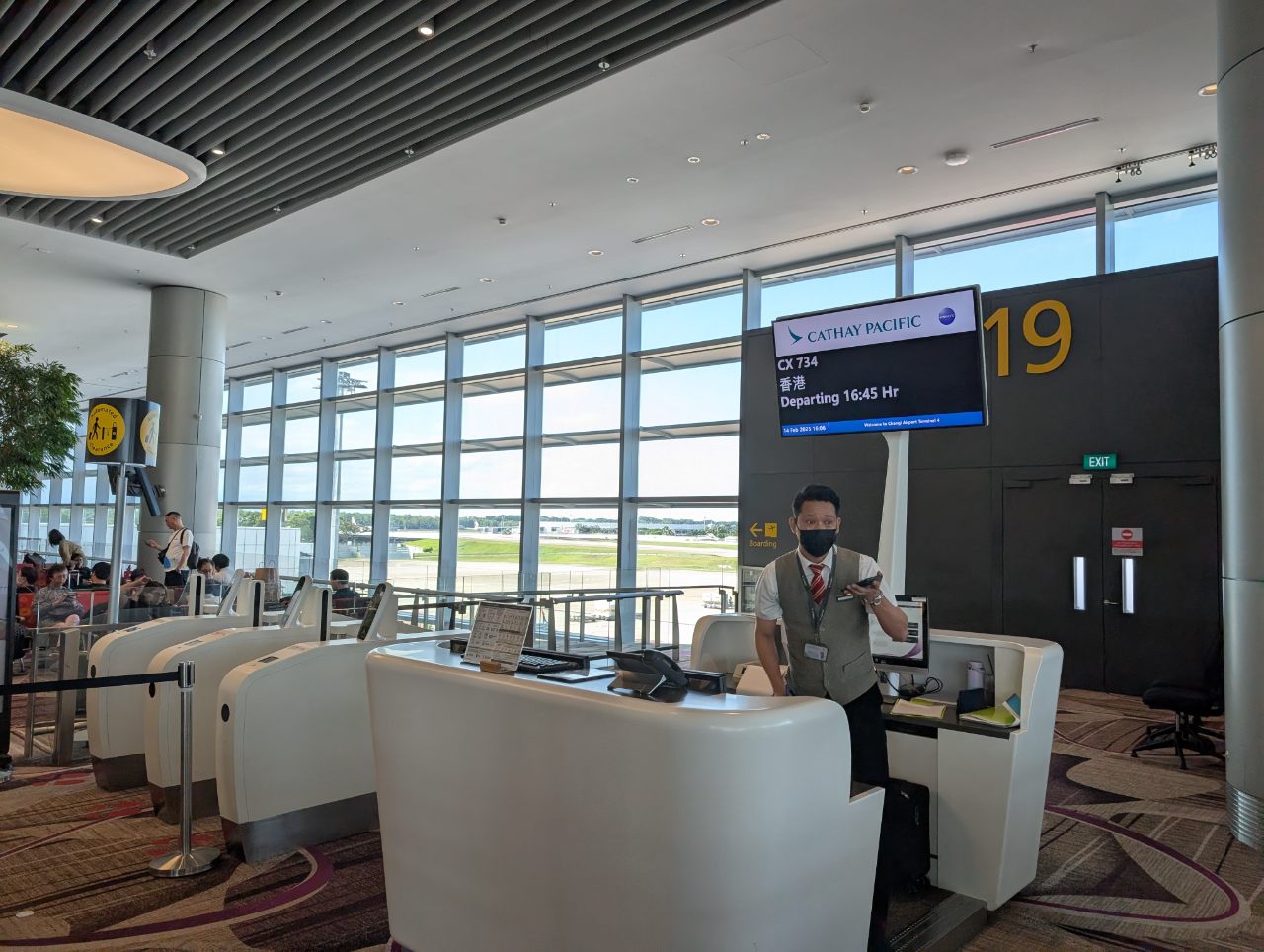
Cathay Pacific B777-300ER Premium Economy Class
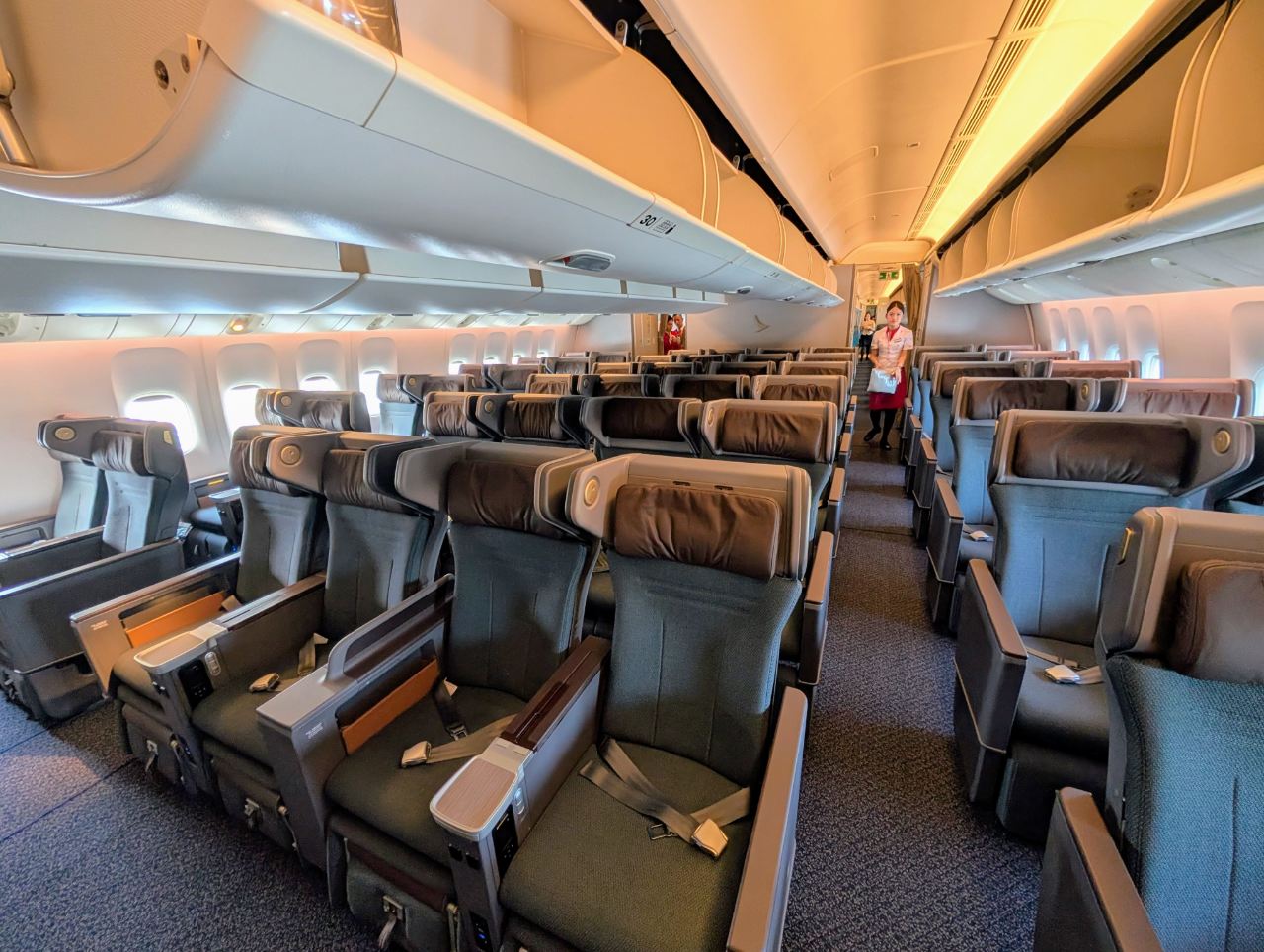
Cathay Pacific has a total of 48 Premium Economy Class seats on its retrofitted B777-300ER aircraft, a 50% increase from the previous 32.
Seats are spread over six rows in a 2-4-2 configuration, with 21 inches of width, 40 inches of pitch and 8 inches of recline.
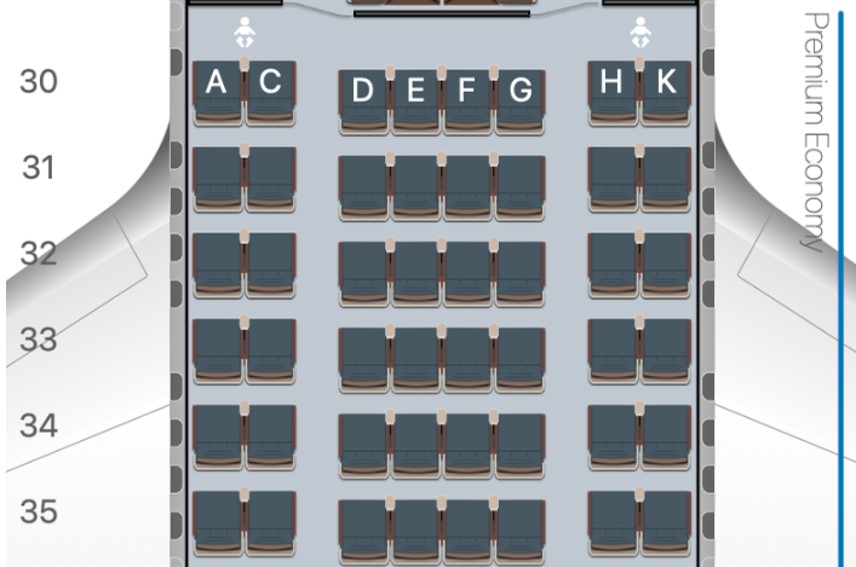
The seat is based on the Recaro PL3530 (also used by Emirates and Starlux), but Cathay Pacific has heavily customised it. JPA Design, the same firm behind Singapore Airlines’ Premium Economy seat, handled the modifications with a particular emphasis on increased privacy and upgraded technology.
If you look at the industry, Premium Economy has historically been seen as a mere extension of Economy: a seat with a slightly wider pitch and a little bit more space. For our Boeing 777-300ER, we have a very clear goal, which is to design Premium Economy as a cabin that thrives on its own merits – a product that reflects the customer’s needs and the premium differentiation.
-Vivian Lo, GM of Customer Experience & Design
They’ve certainly done a good job with that, because Premium Economy very much looks and feels like a cabin in its own right. Unlike some airlines which don’t even bother to put a cabin divider between Economy and Premium Economy (looking at you, Lufthansa!), Cathay has created a distinctly different vibe for this cabin, with the sleek new seats looking inviting from the moment you step in.
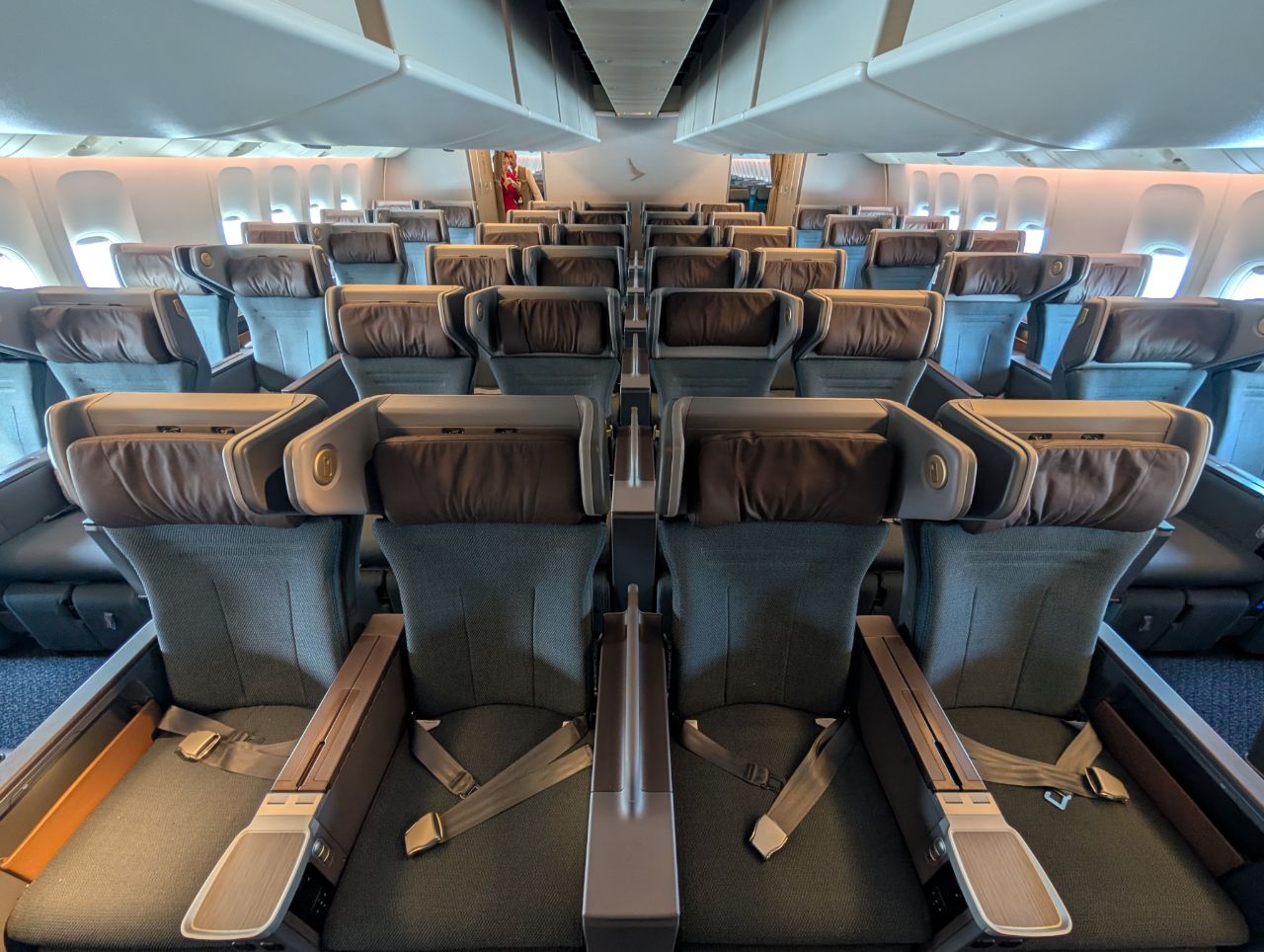
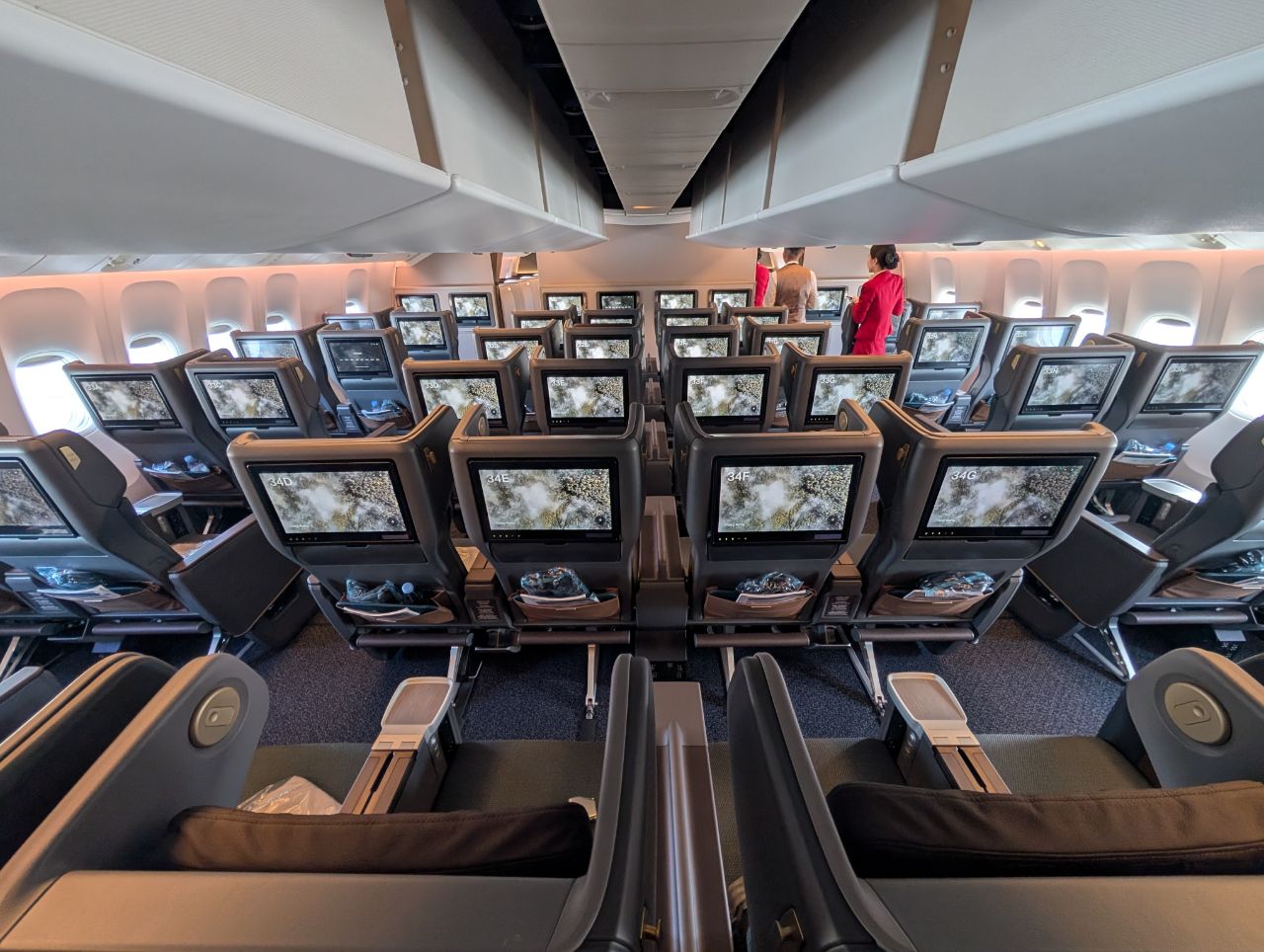
I also managed to snap some quick photos of Economy Class. Cathay has not developed a new seat for this cabin, but has updated the upholstery and added new flexible headrests. Overhead baggage space has also been improved, and the inflight entertainment system updated to offer Bluetooth audio connectivity (no 4K screens here though!).
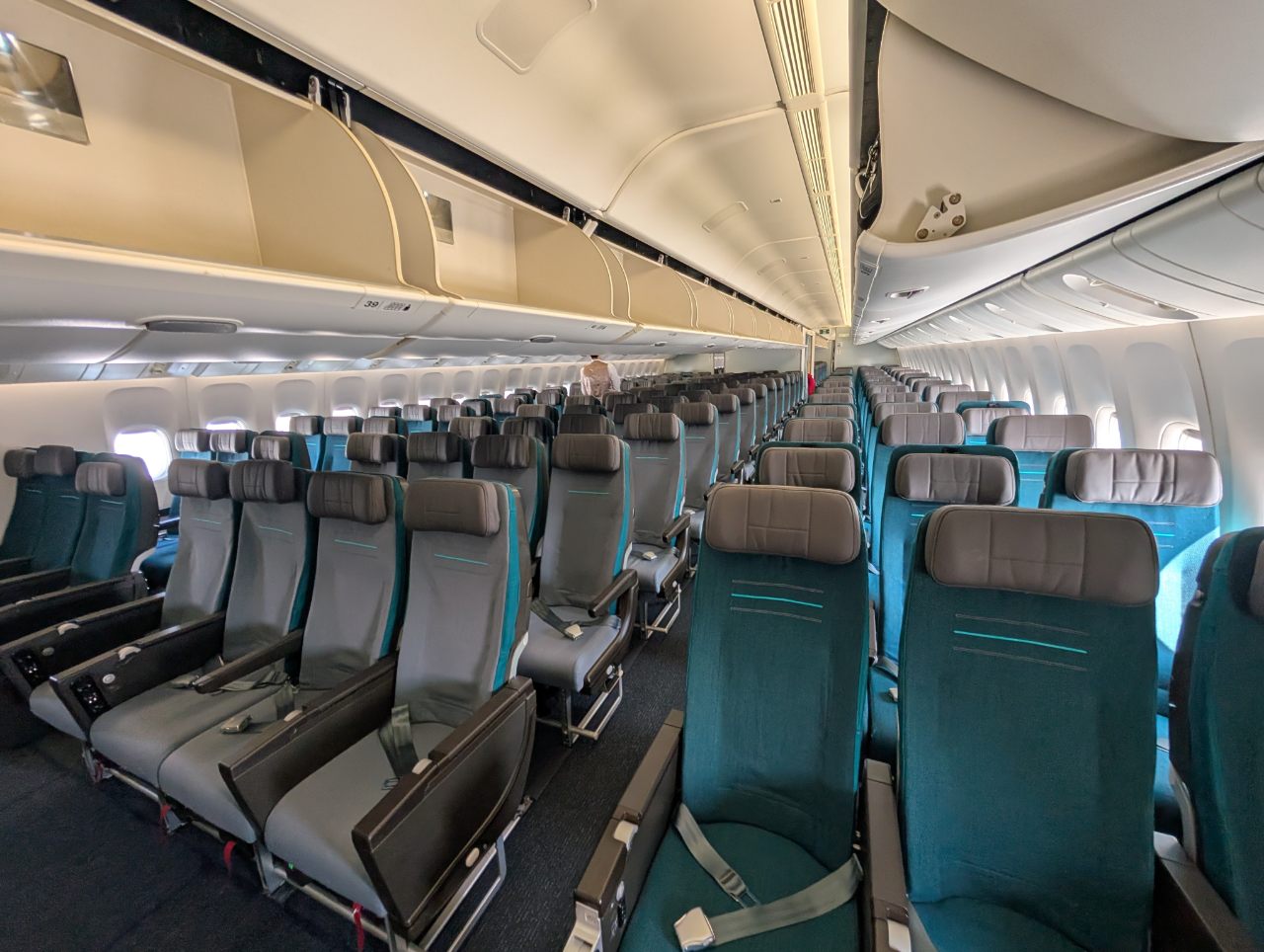
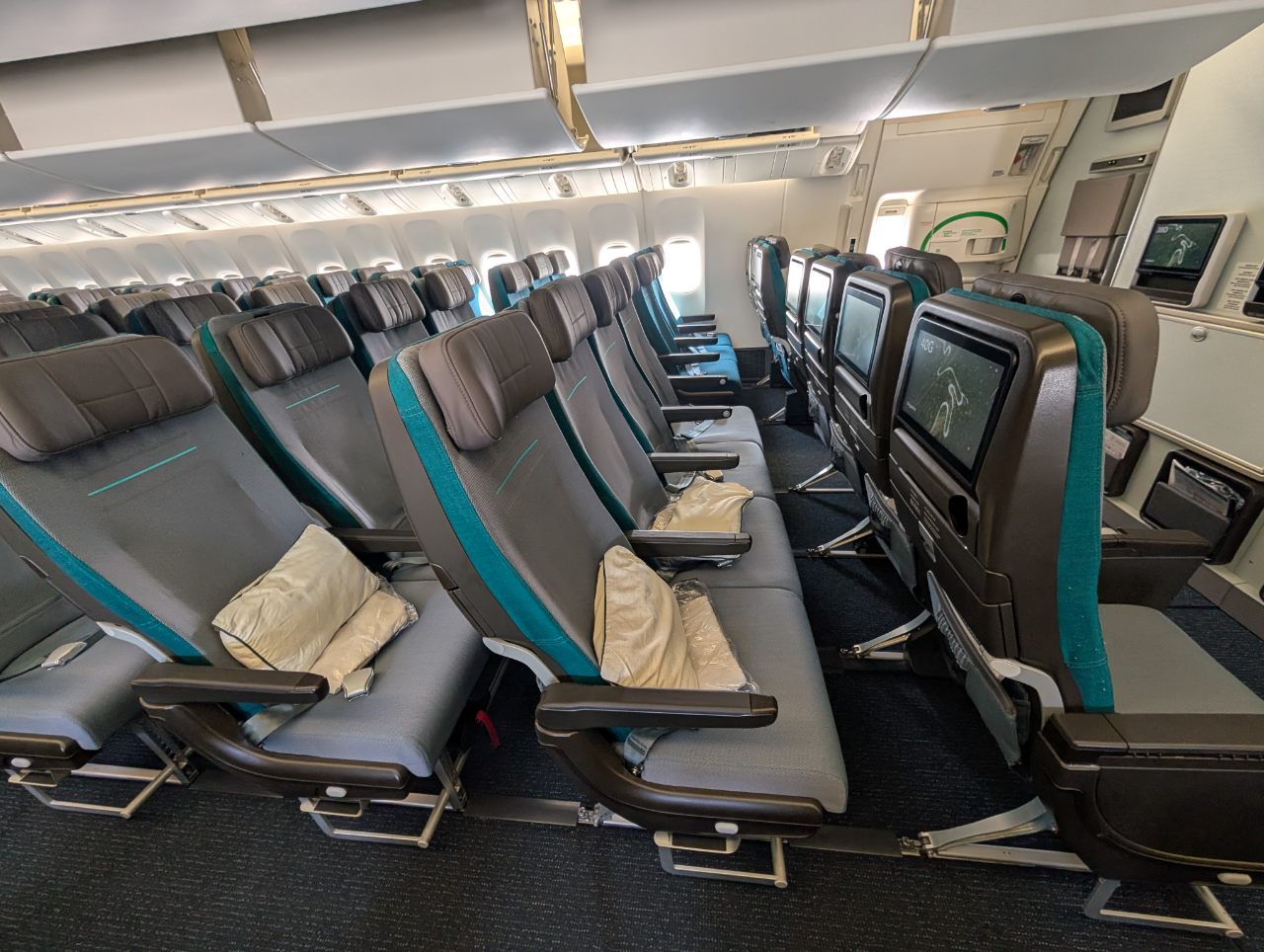
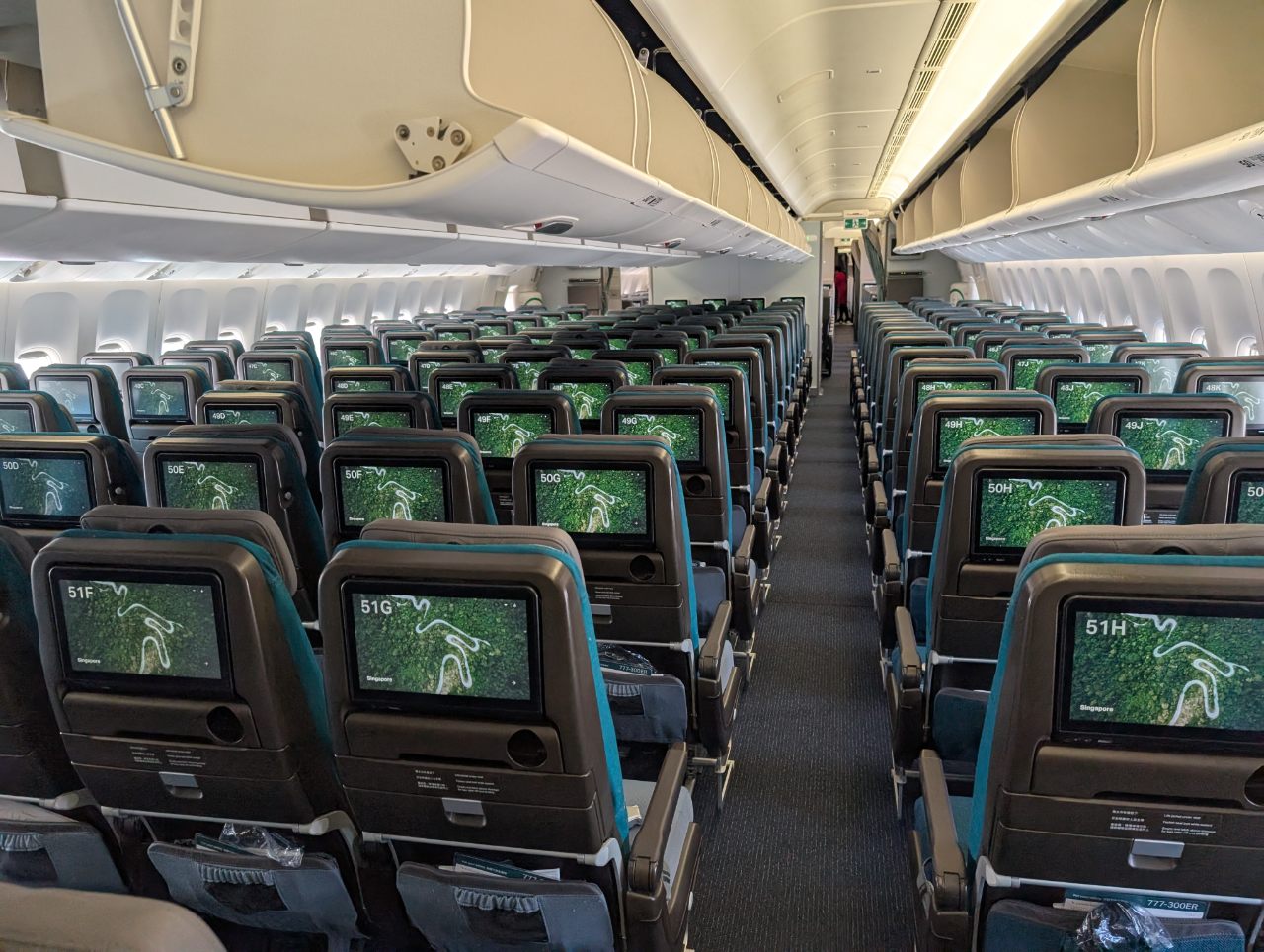
Back to Premium Economy, and the first row of seats is unique, in the sense that these bulkhead seats have their inflight entertainment monitors mounted on the wall. They also lack the forward foot bar, and instead have a footrest which unfolds separately from the legrest. The key advantage here is that no one can recline into your personal space- which given this seat’s generous recline, might be very welcome (more on that later).

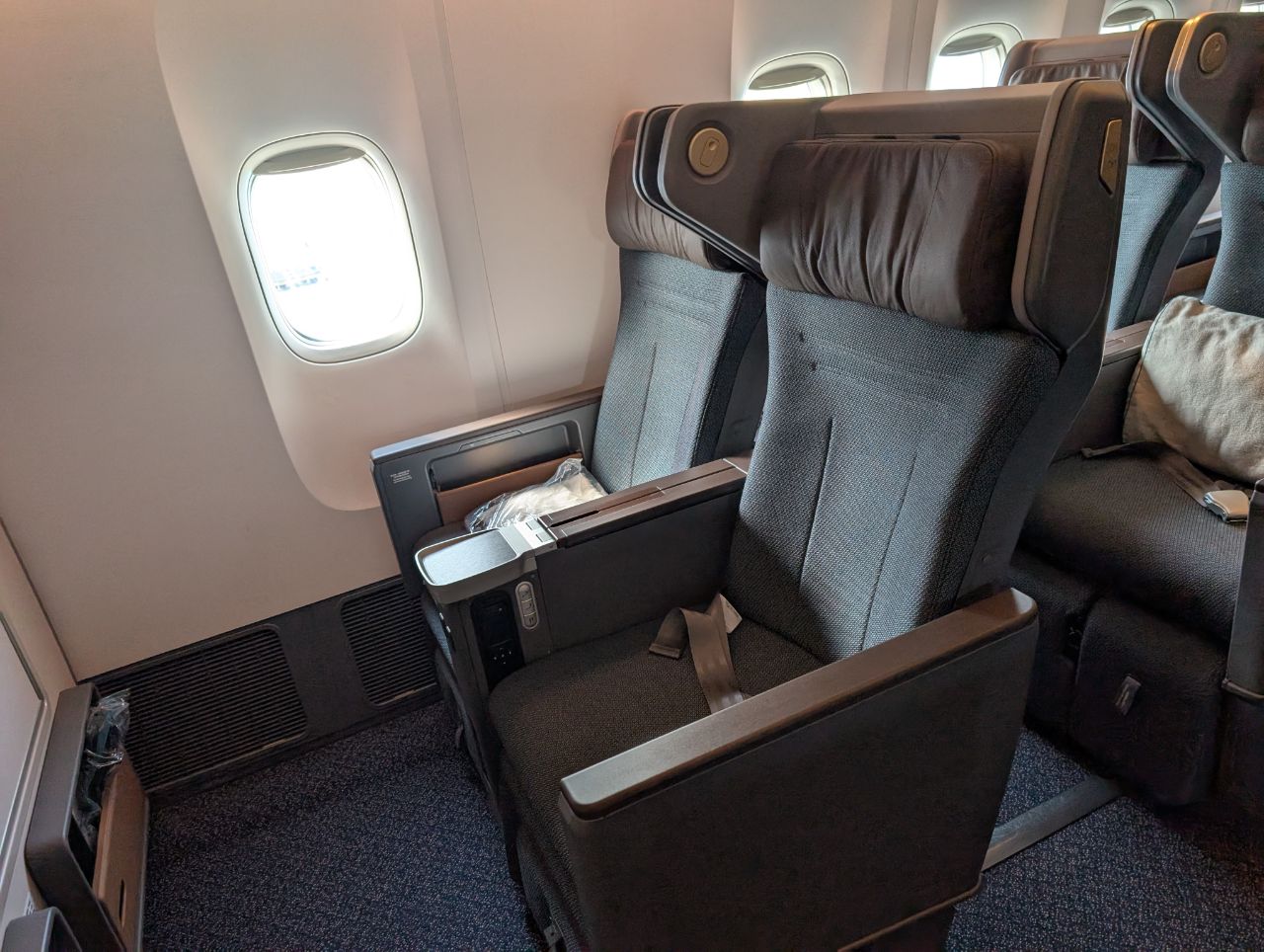
Couples will obviously prefer the two seats located by the windows, and these were the first to get snapped up. Less popular, understandably, were the two middle seats in the centre of the aircraft.
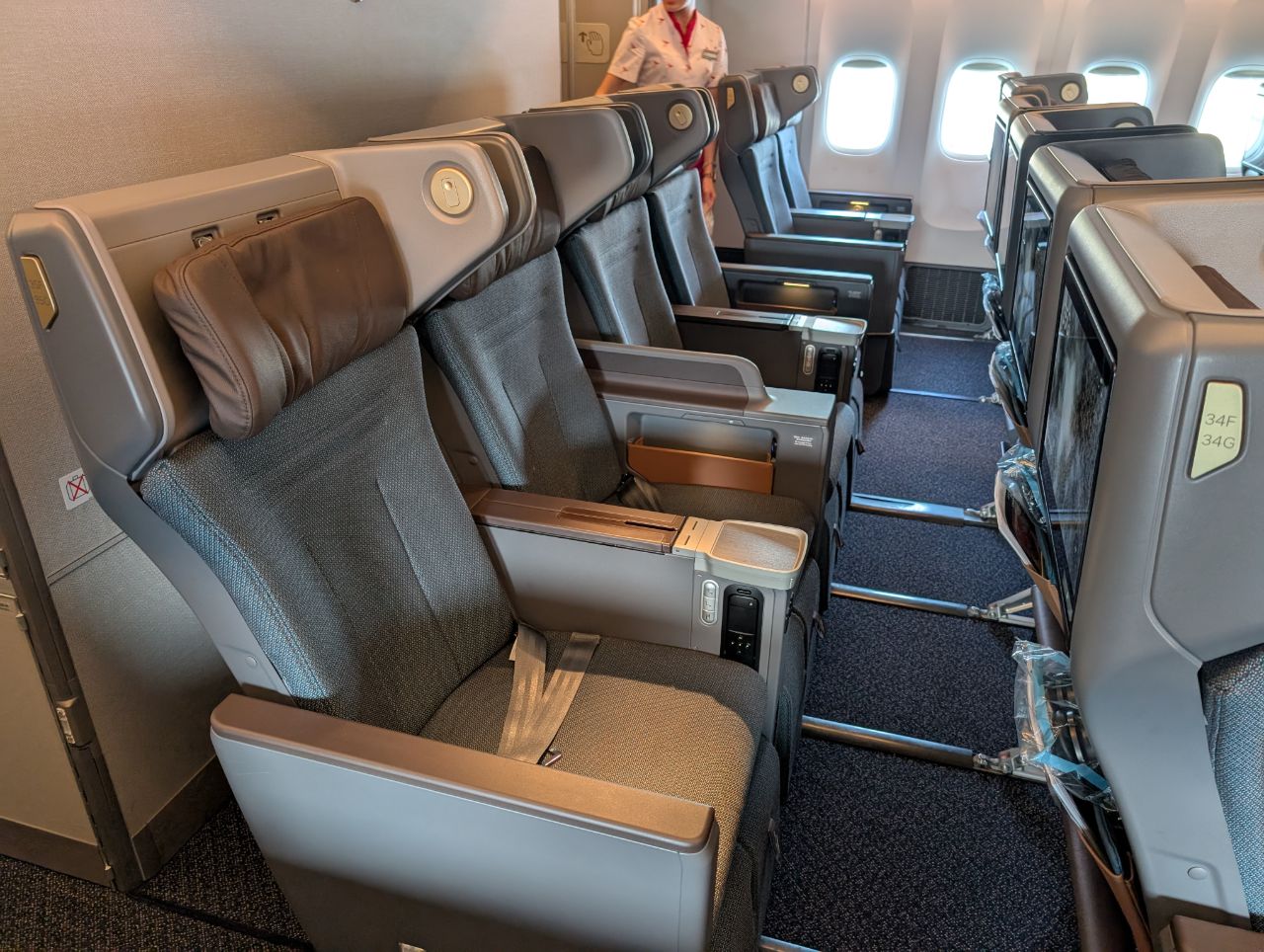
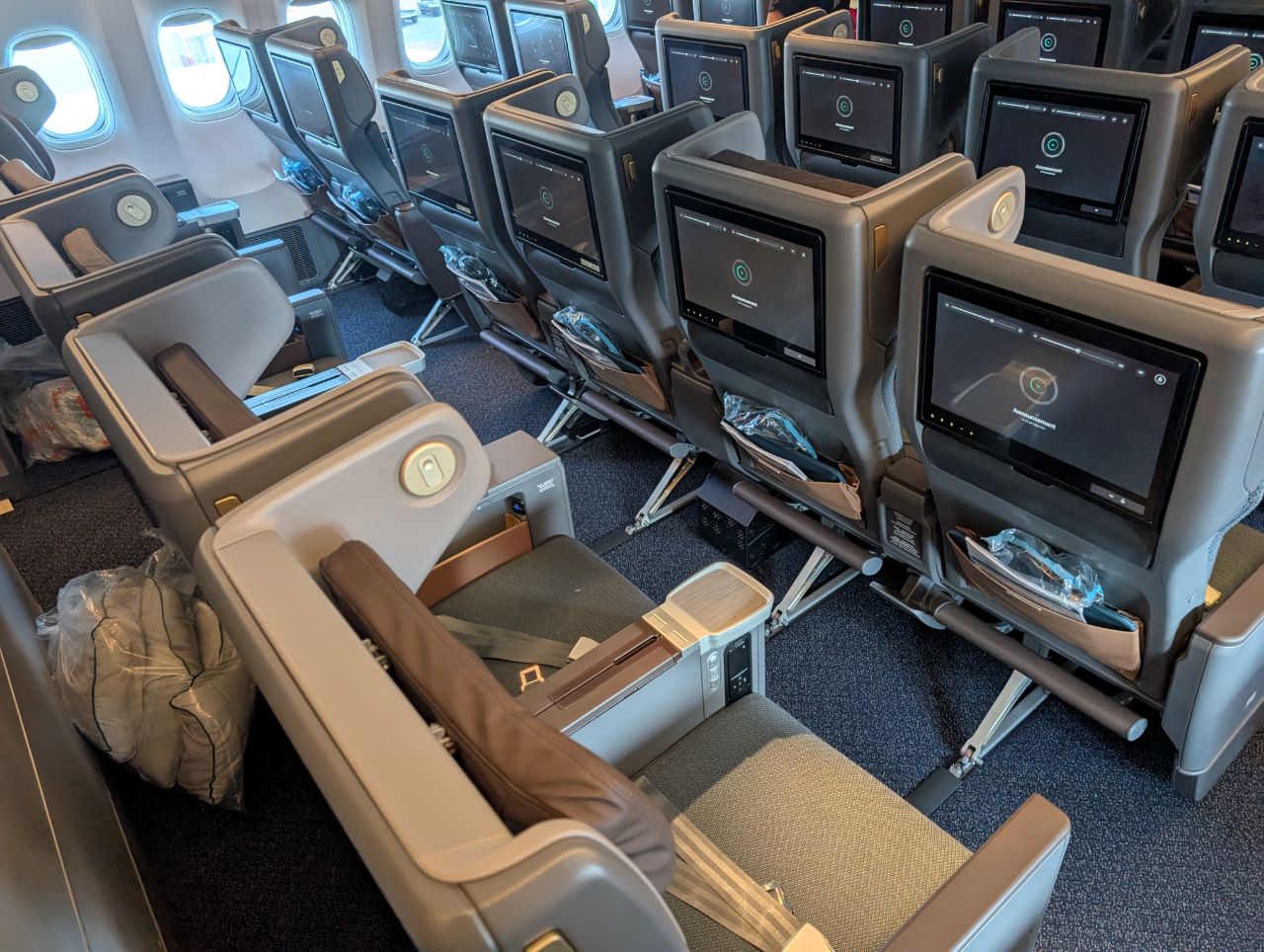
But even if you’re seated next to a stranger, you’ll appreciate the fact that seats have a distinctive privacy wing around the headrest, which provide visual isolation (these wings are absent from the side that faces the aisle).
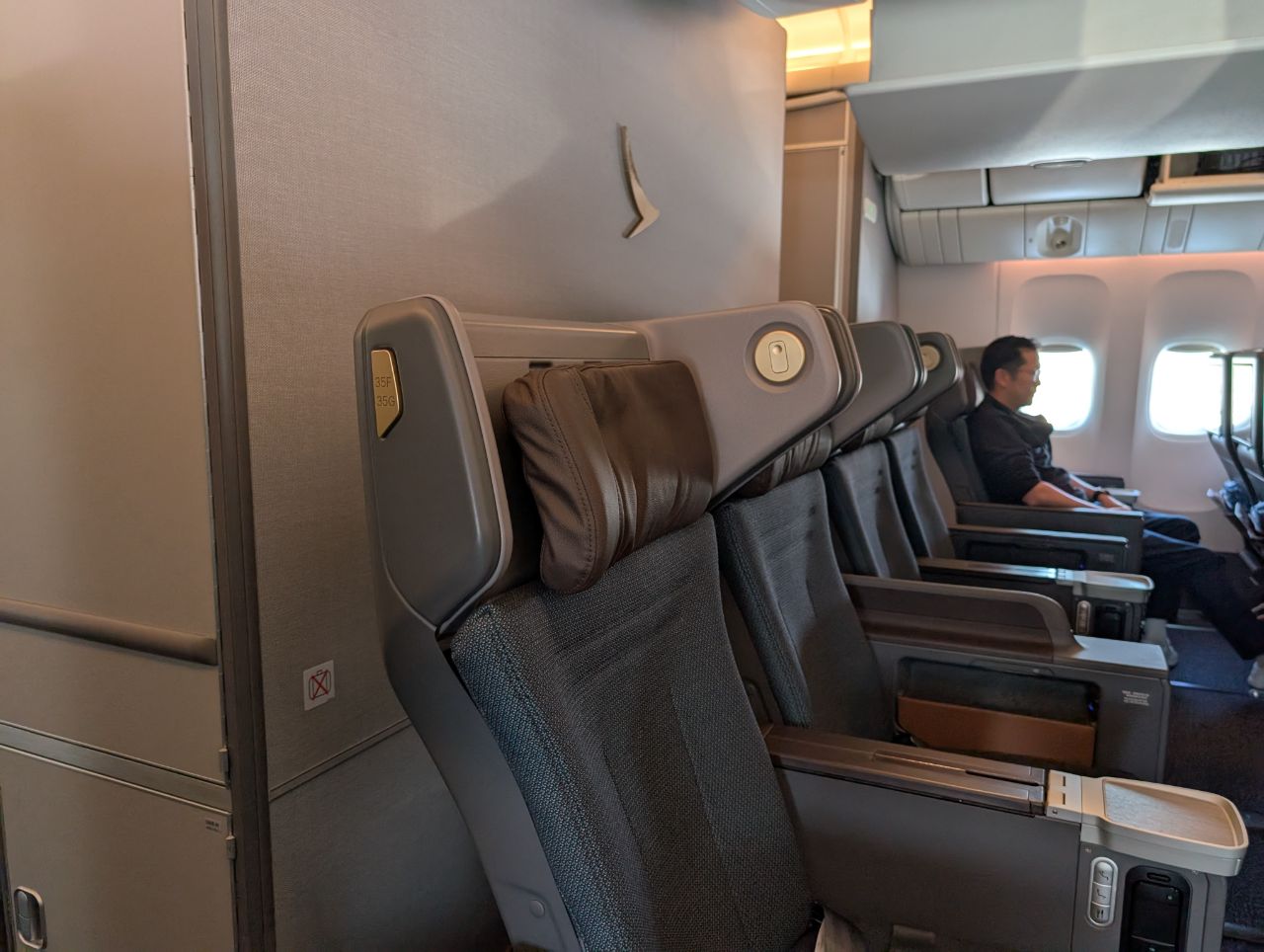
The privacy wings help sell the idea that each seat is a personal enclosure, rather than part of an amorphous blob. In practice, this works pretty well, though you’ll only fully appreciate the effect once your seat is reclined (see the second photo below).
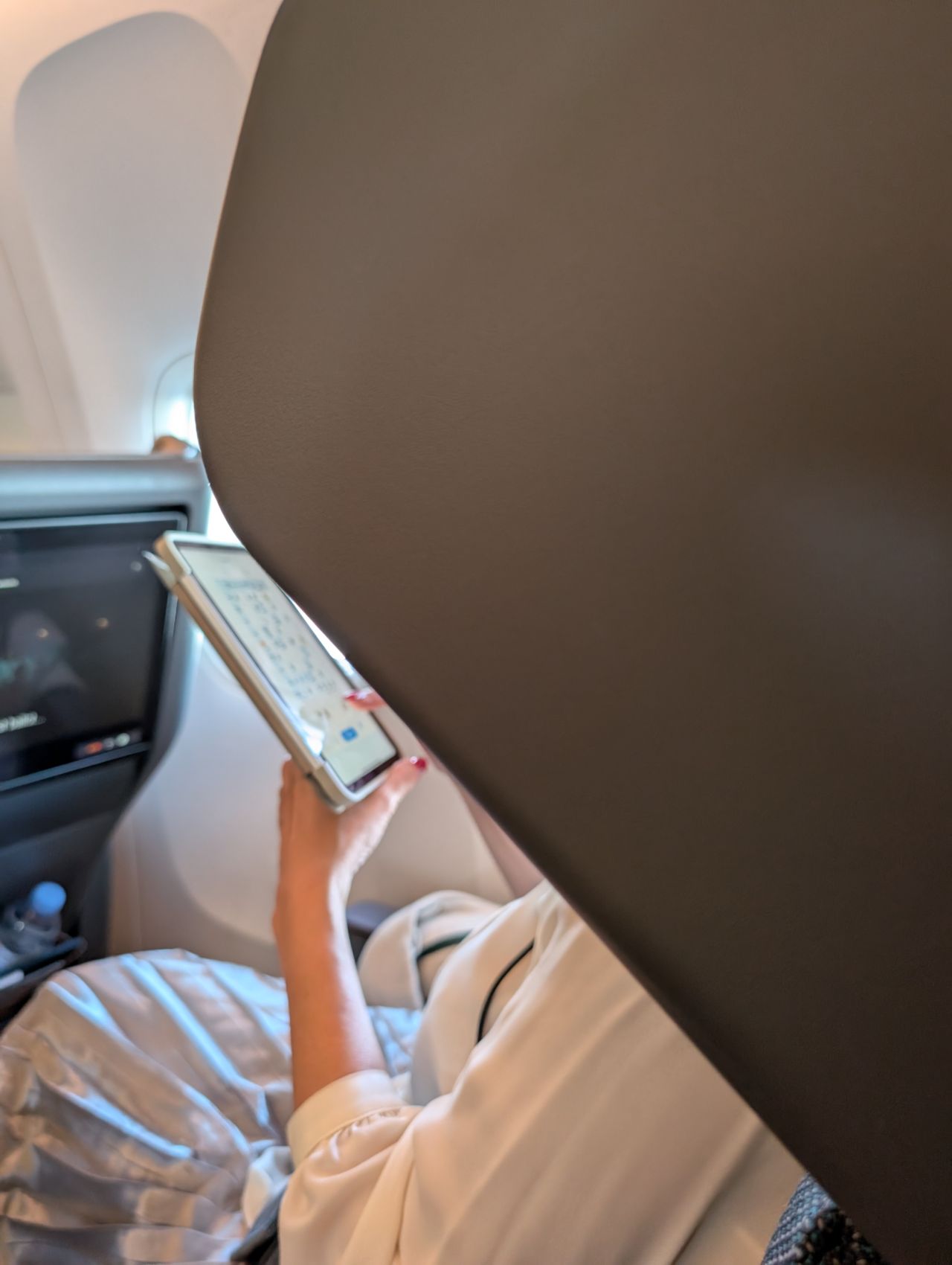

The privacy wing has an embedded reading light, in a tasteful gunmetal finish. This is much easier to access than the snake-style reading light on Cathay’s previous generation Premium Economy seat, and more intuitive to operate too.
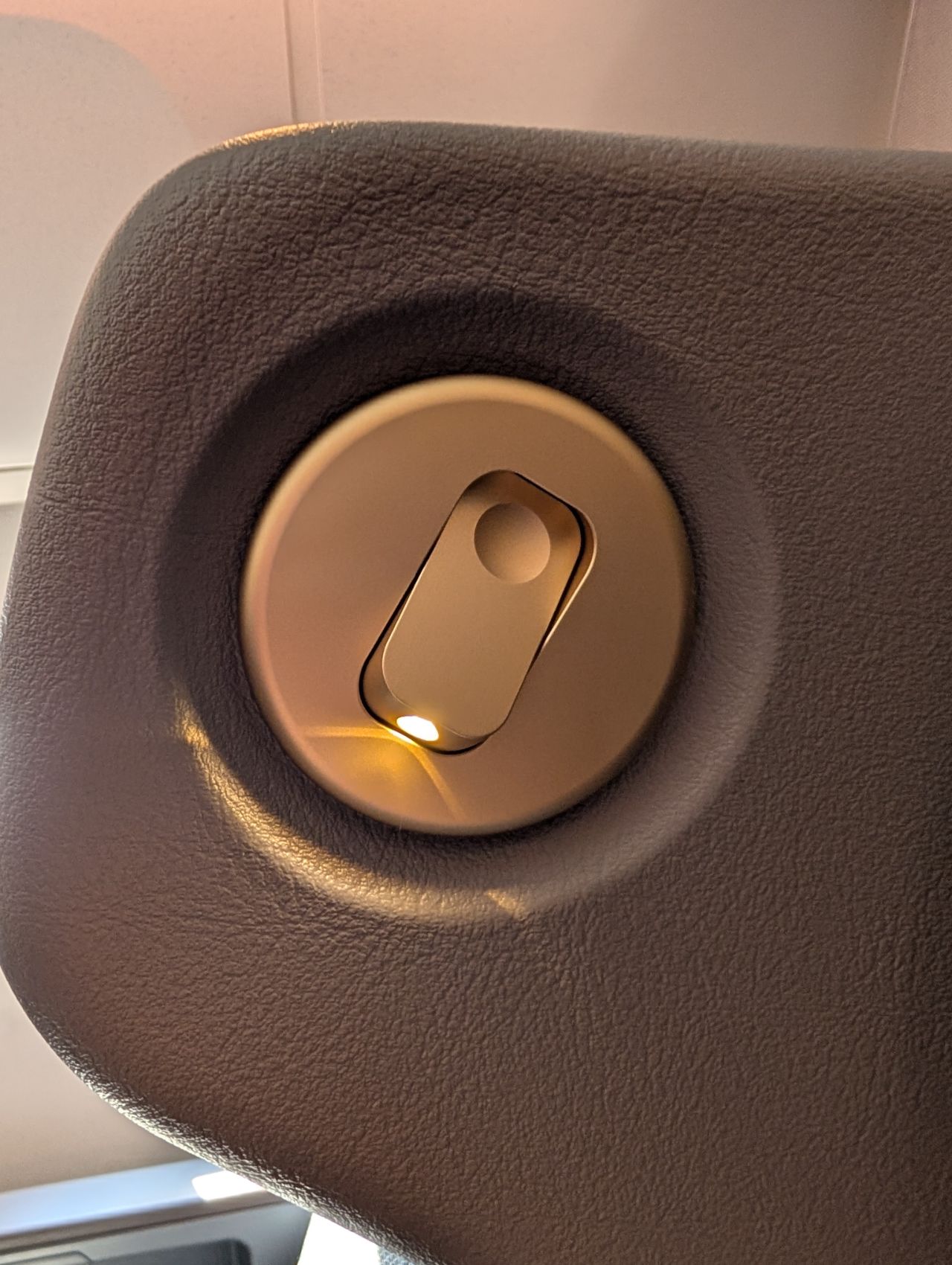
On the outward facing side of the wing is a subtle coat hook, useful for hanging a jacket.
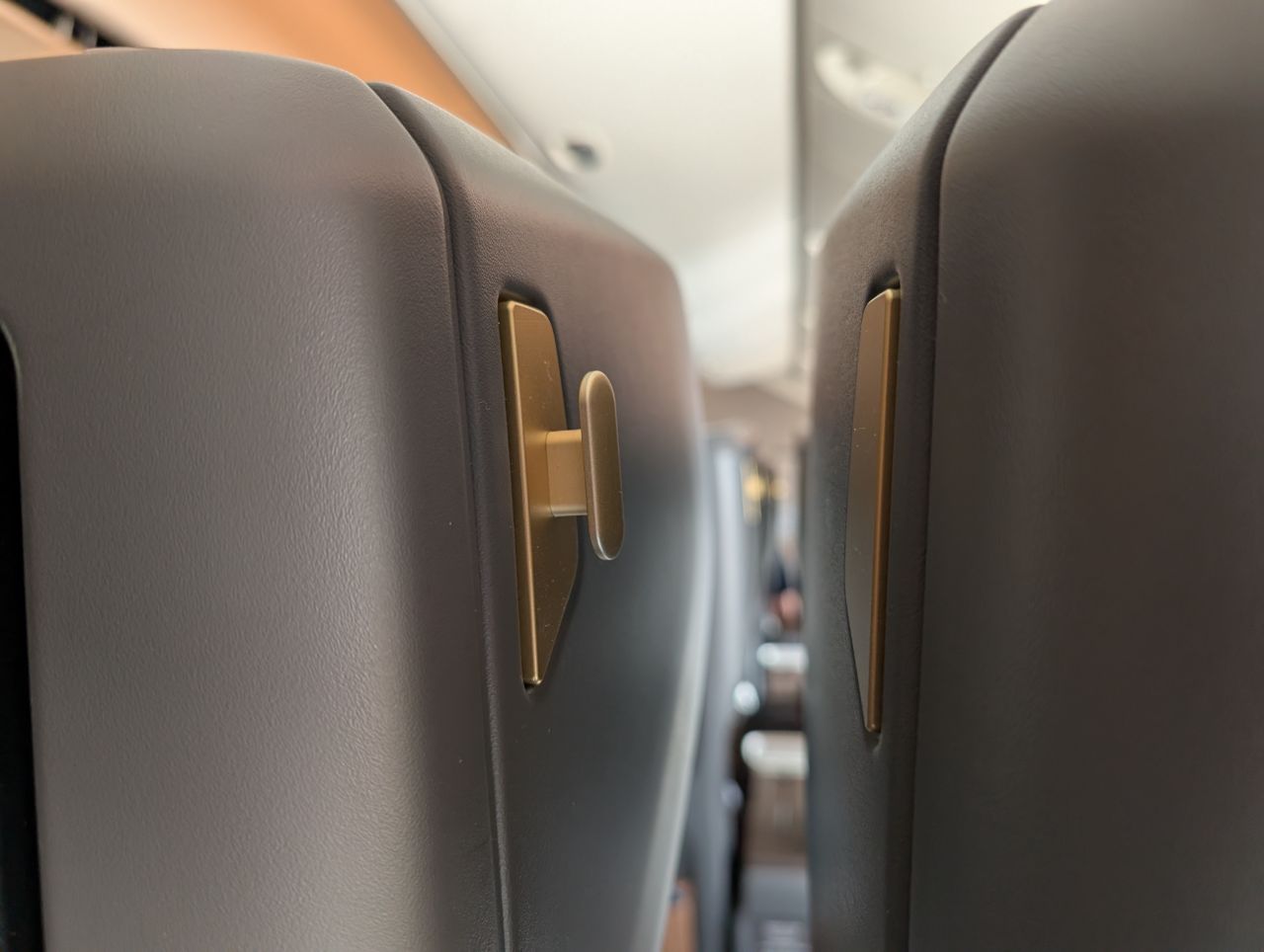
Each seat has a huge 15.6″ inflight entertainment screen with 4K resolution (which I’ll touch on in a different section), below which you’ll find the literature pouch and a fold down footrest.
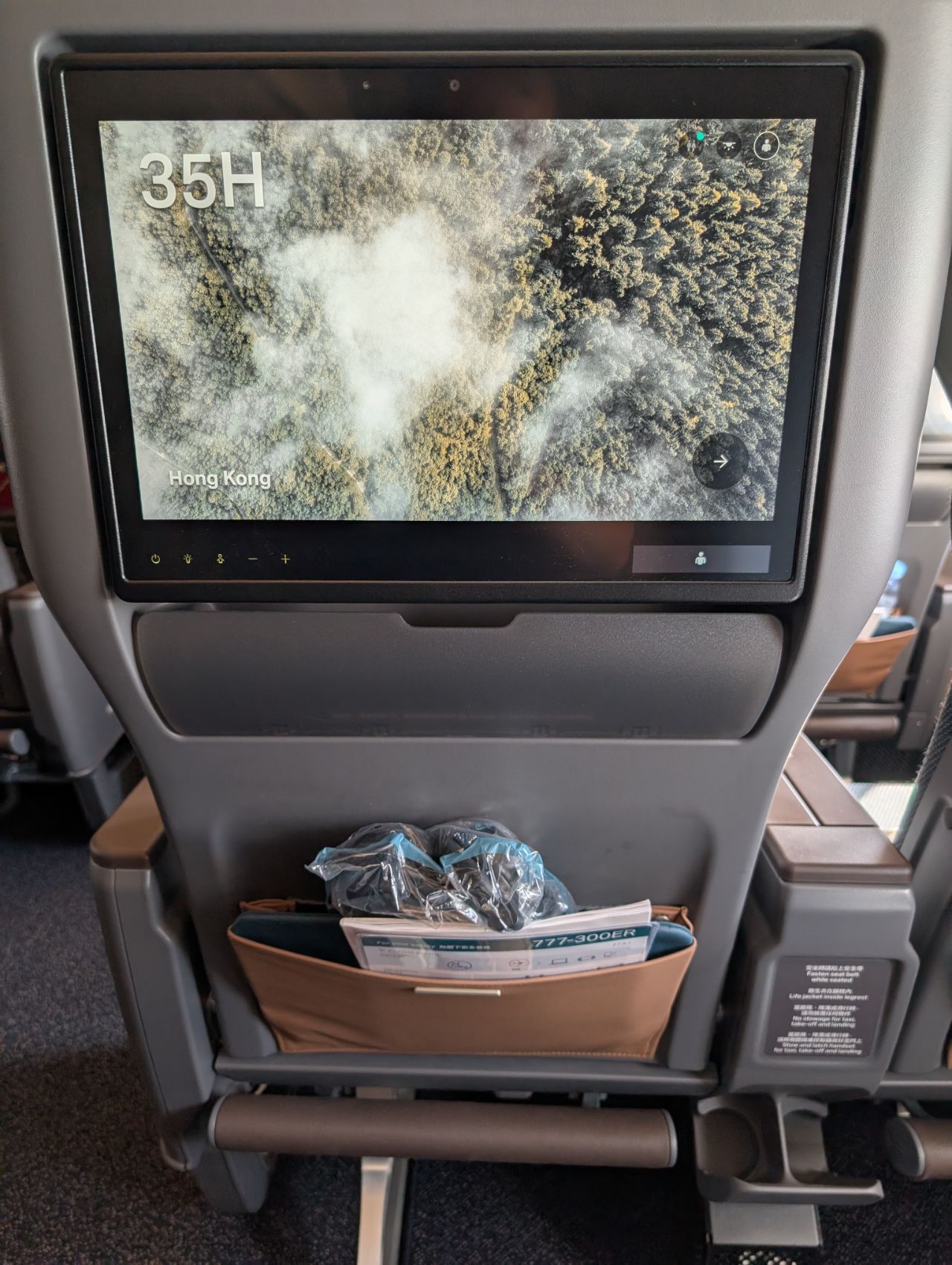
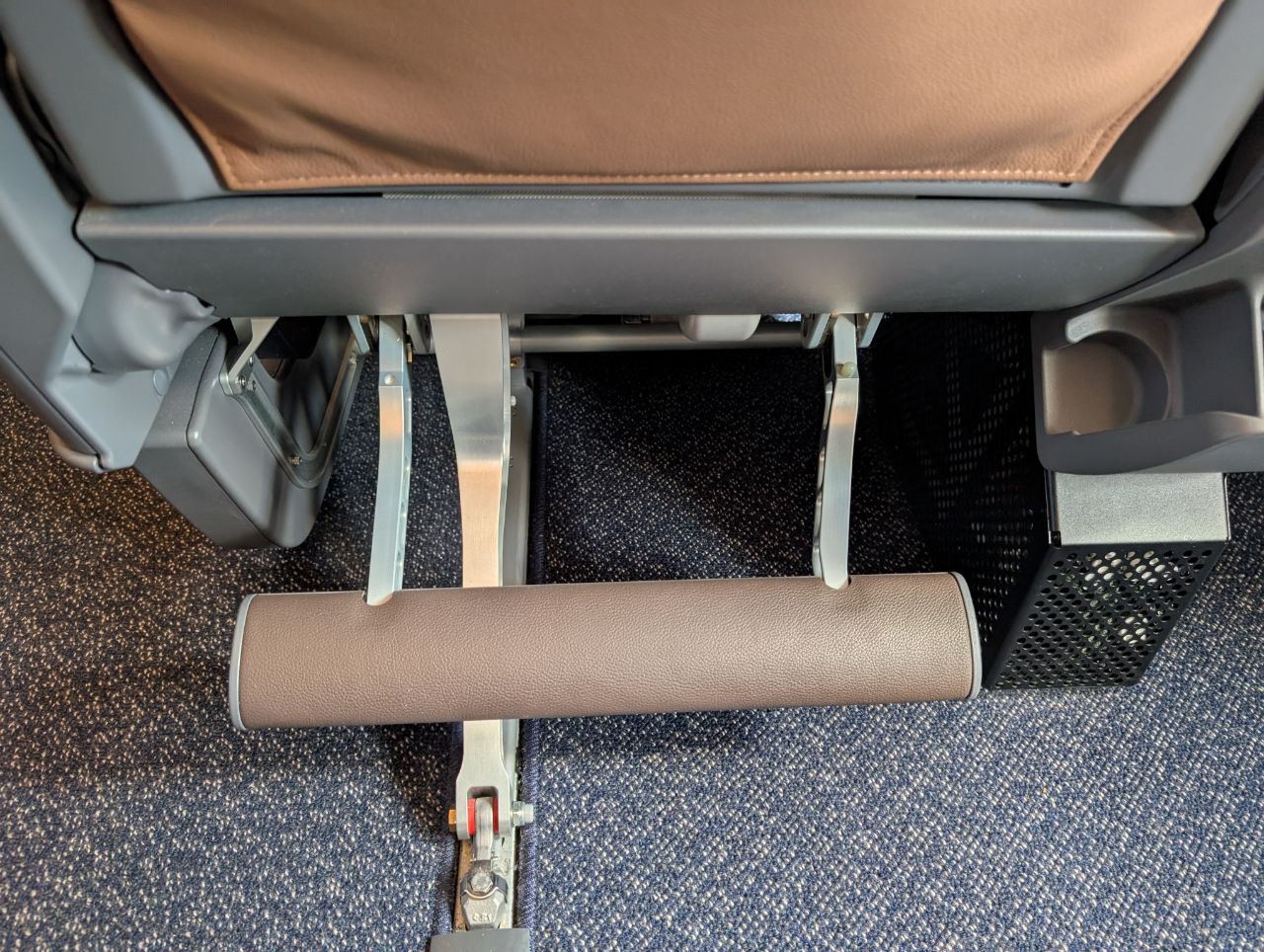
This can be used in conjunction with the legrest that flips up from beneath your feet, providing a good platform for napping.
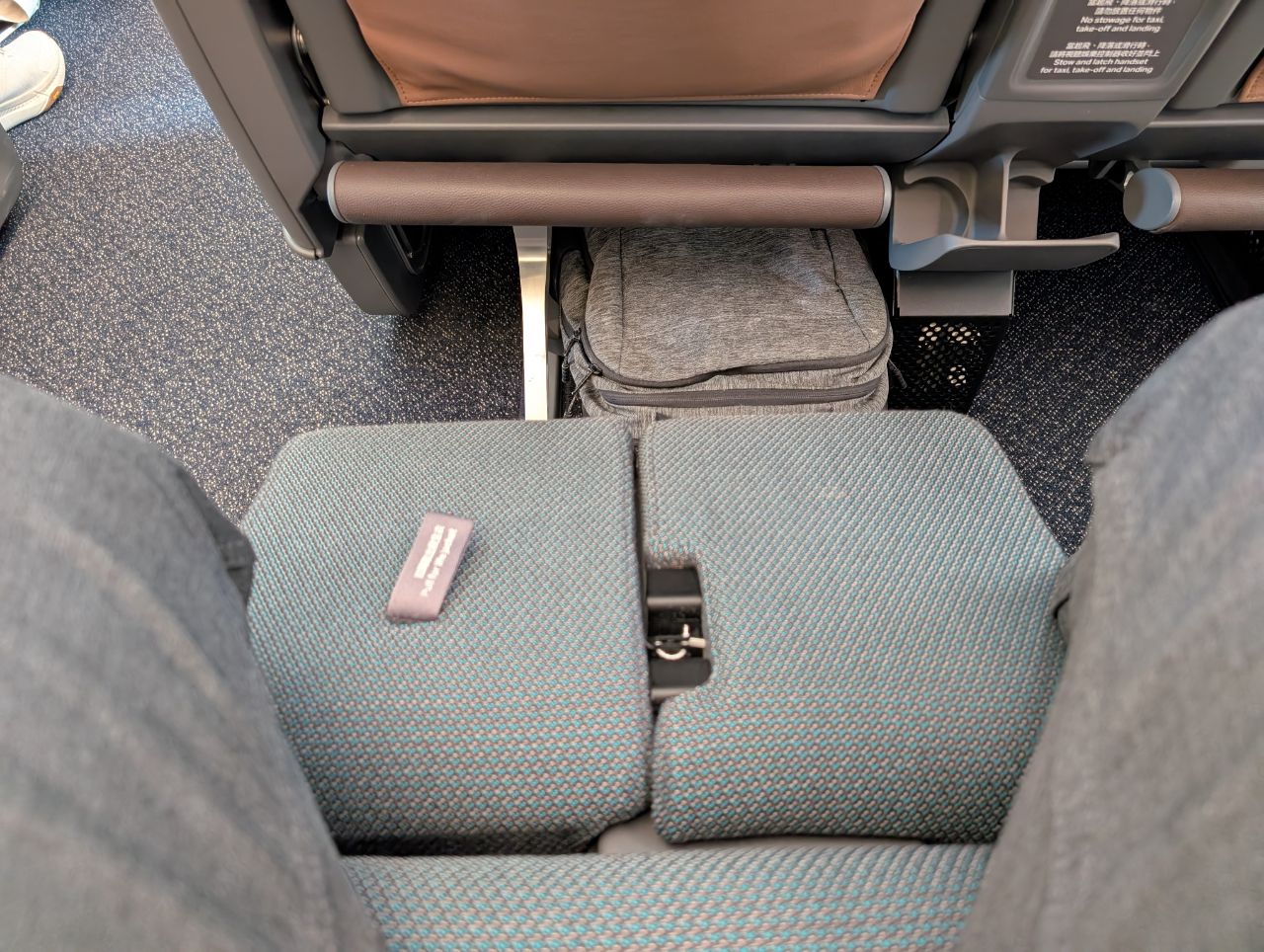
A pair of water bottle holders are located between each pair of seats. Some seats had a bottle of Evian water at boarding (presumably for passengers with elite status).
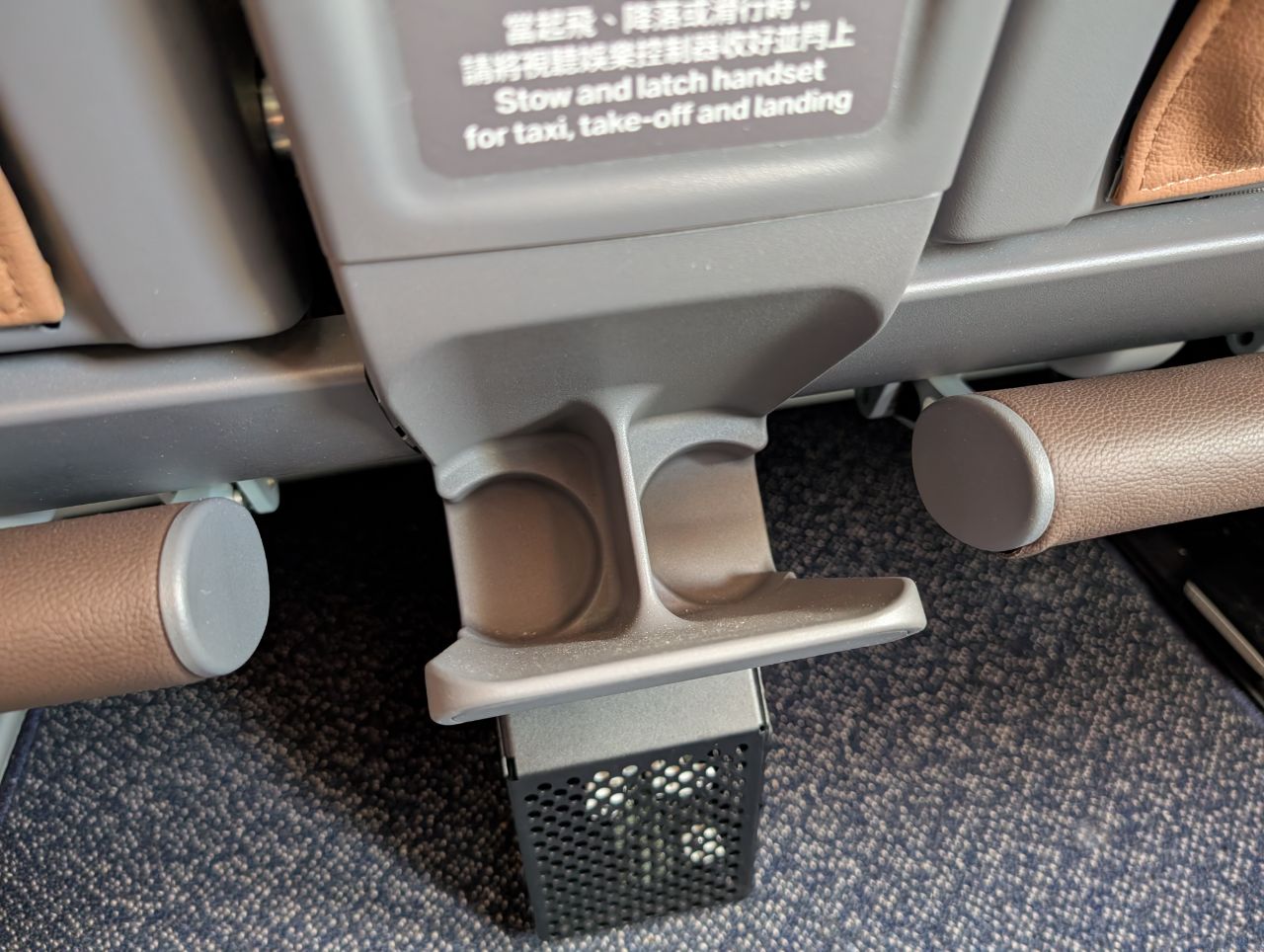
There are several options for storage. First, there’s a plastic flap beneath the TV screen that folds down to serve as a tablet or phone holder. Behind it is a storage nook, suitable for storing cables, reading glasses, a mobile phone and other loose items (this is meant to be kept empty for taxi, takeoff and landing).
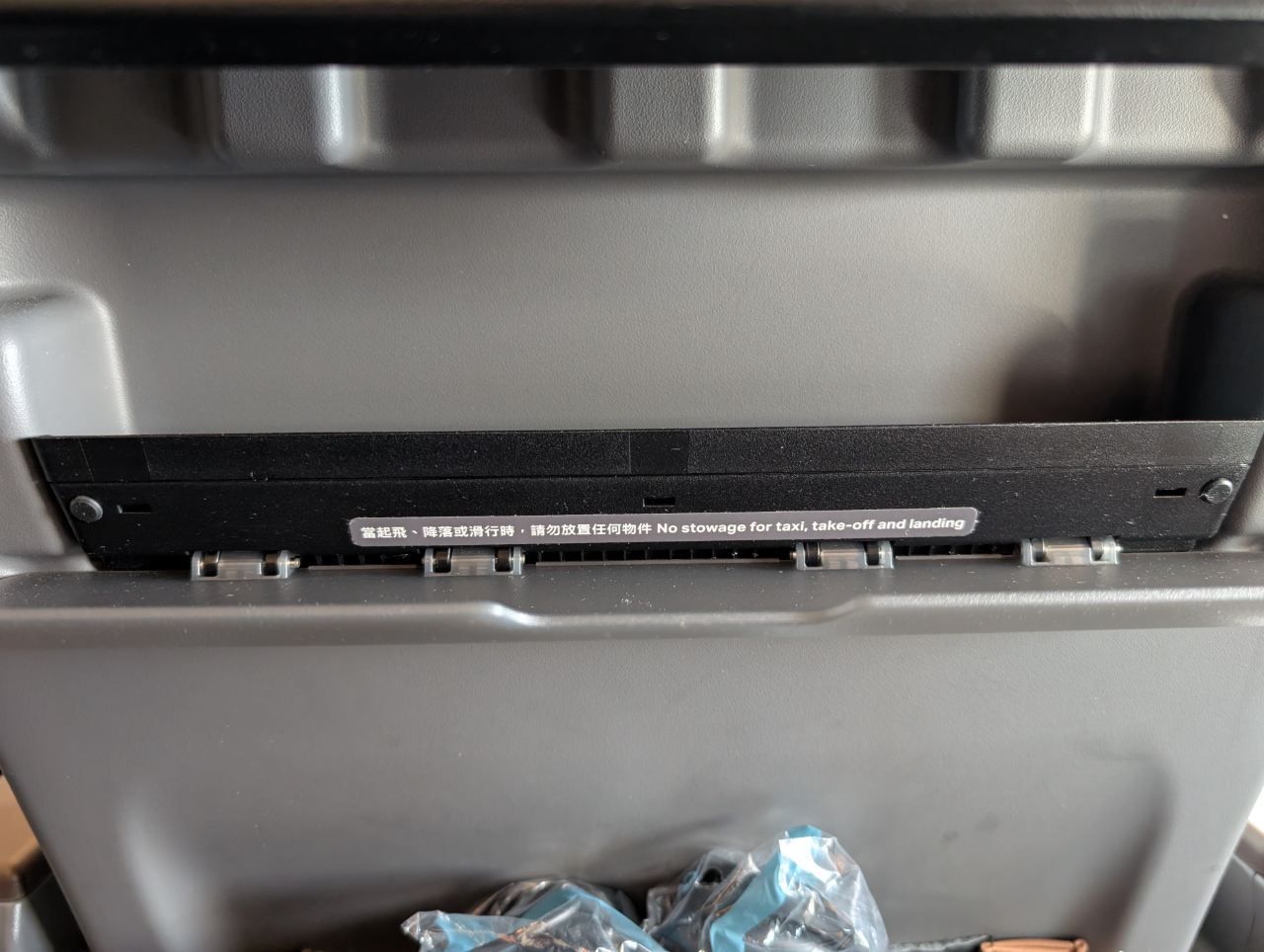
Second, there’s the literature pouch where the safety card and duty-free magazine are stored. This will also fit a laptop of up to 13 inches.
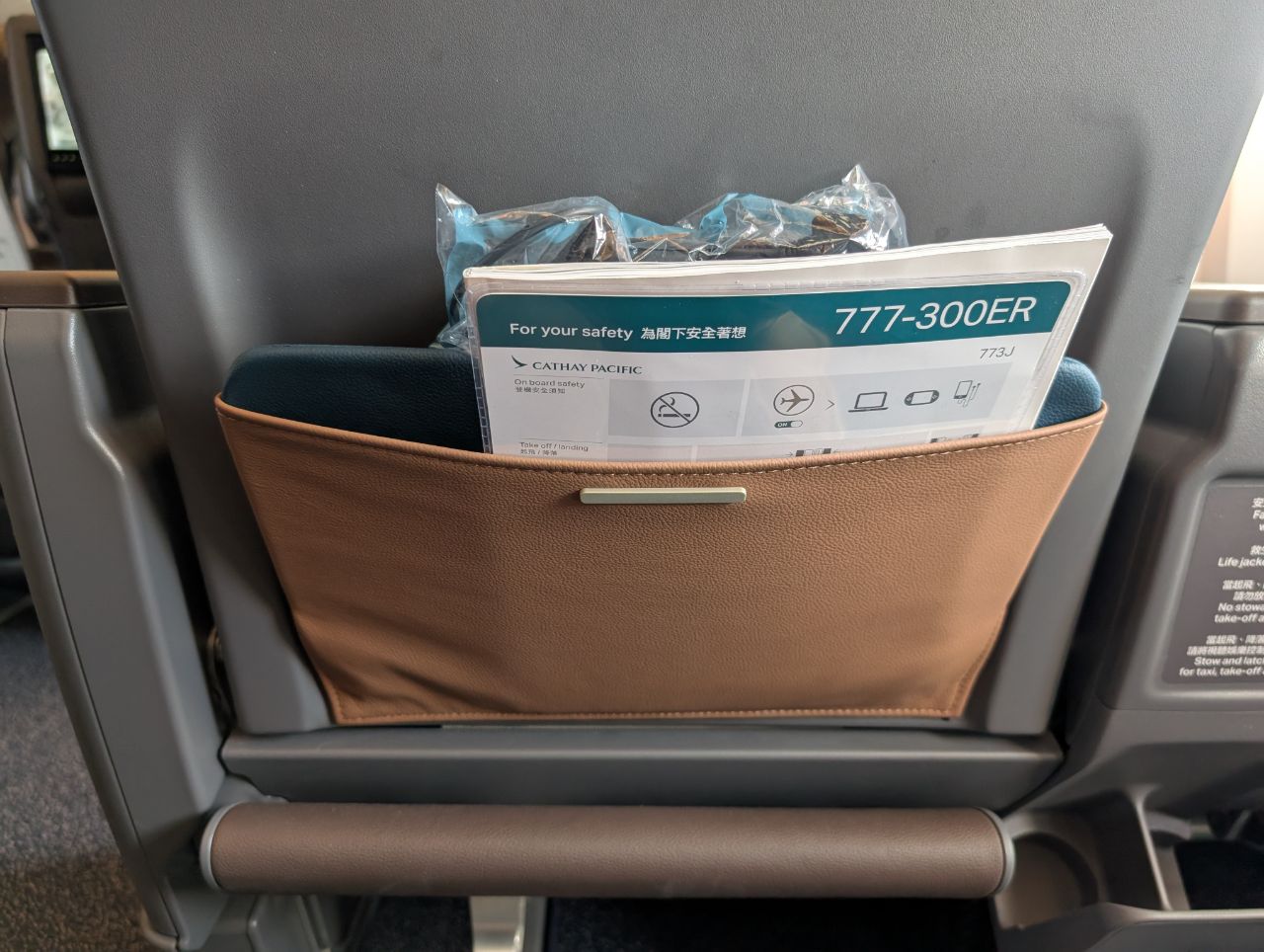
Third, the space beneath the seat in front of you can fit a small backpack, though note the anchoring strut that can obstruct your foot movement.
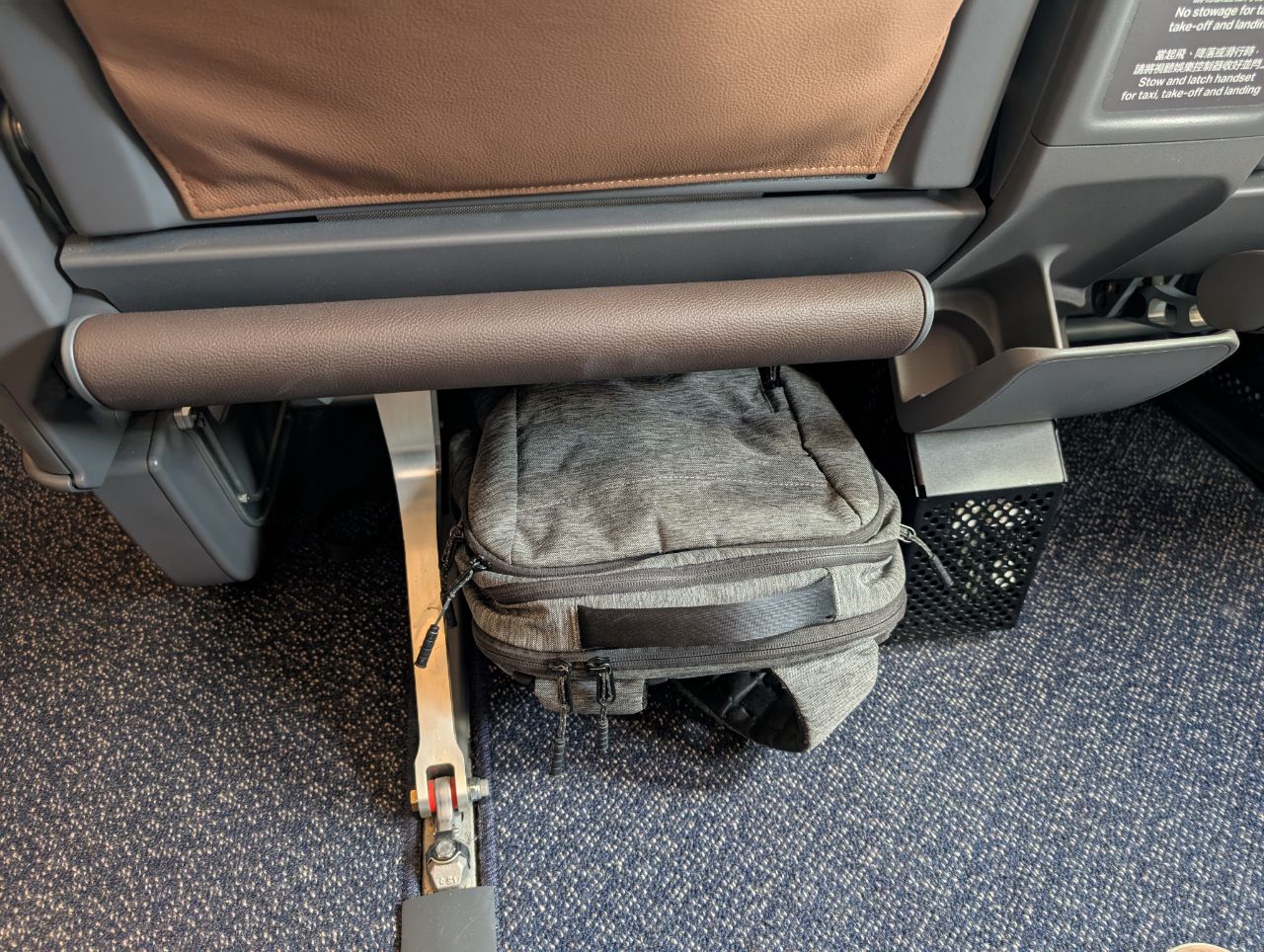
Fourth, under the armrest is a tan leather clad slot that will fit a tablet. The seat’s USB-C slot is also thoughtfully located here, so you have a place to stow your device while it juices up and not have the wire running across the seat (as is the case with other airlines where the port is on the seatback).
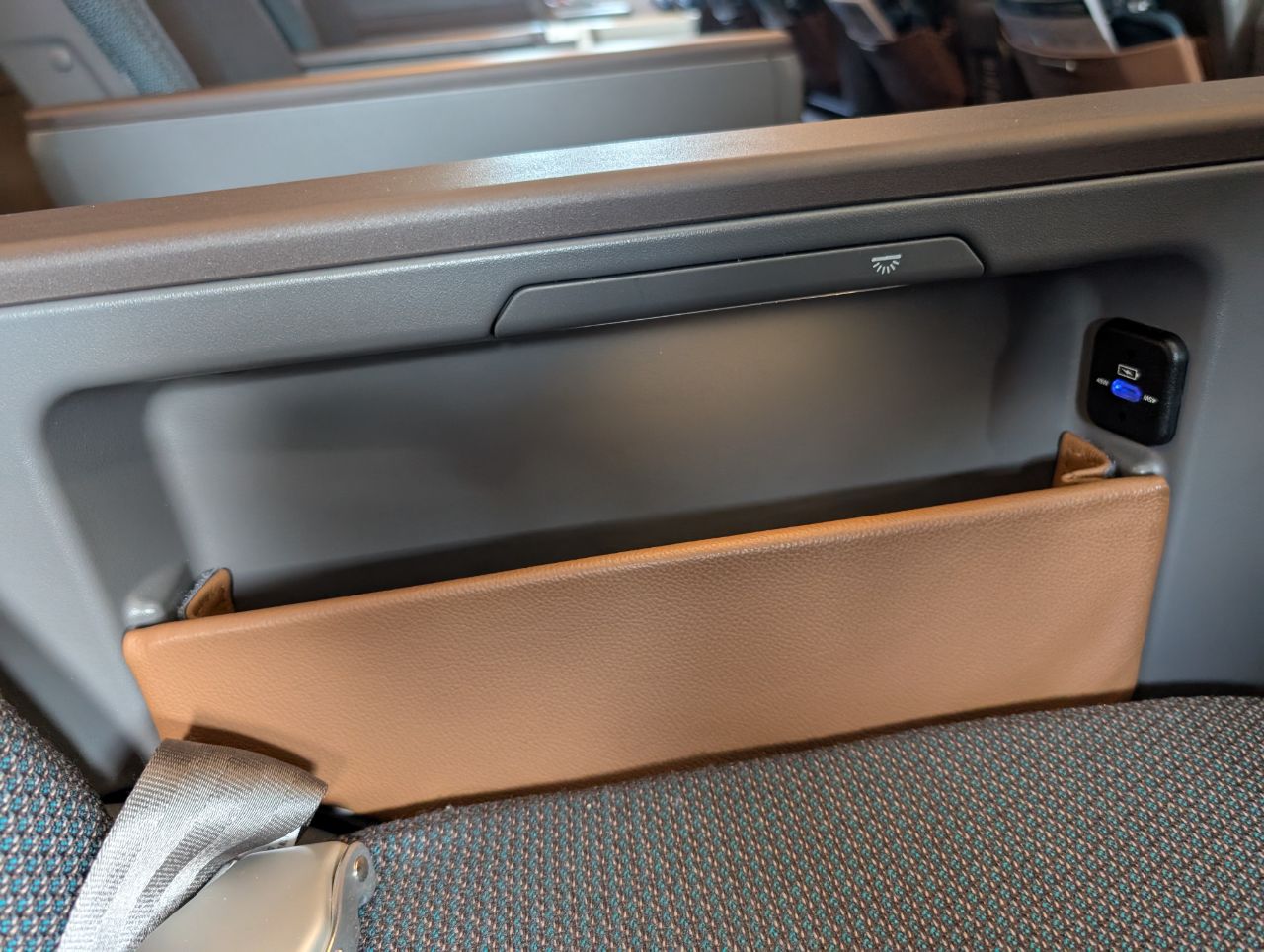
Seat controls are manual, which is expected as motorised controls would add too much weight (Japan Airlines is the only airline so far to have introduced electric seat controls in Premium Economy, as far as I know). It’s probably because the seats are so new, but I did observe that some passengers had issues pressing the buttons as they were too stiff. The lady seated next to me had to solicit the help of the cabin crew every time she wished to recline. Hopefully, the mechanism will loosen over time as the seats get broken in.
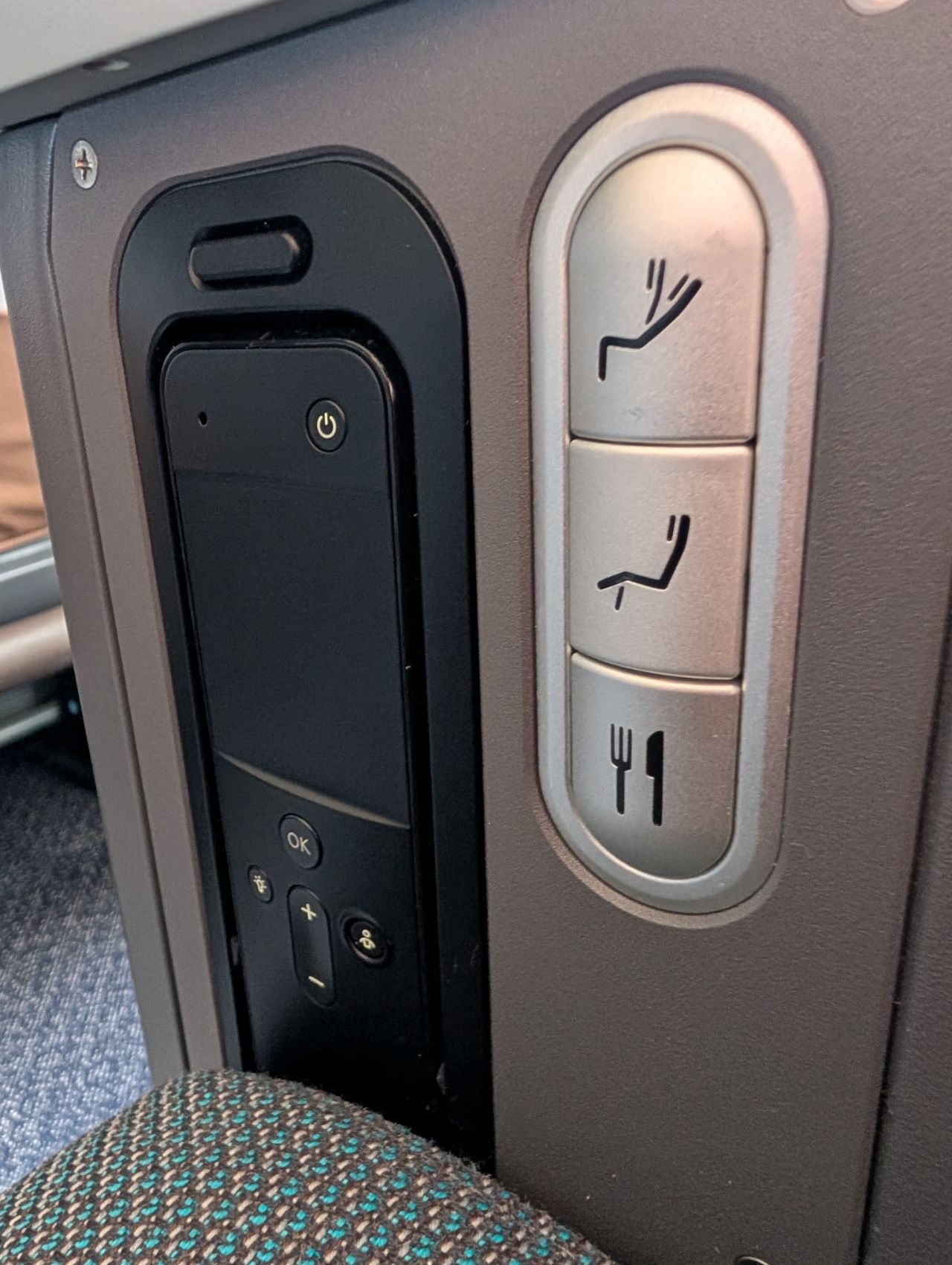
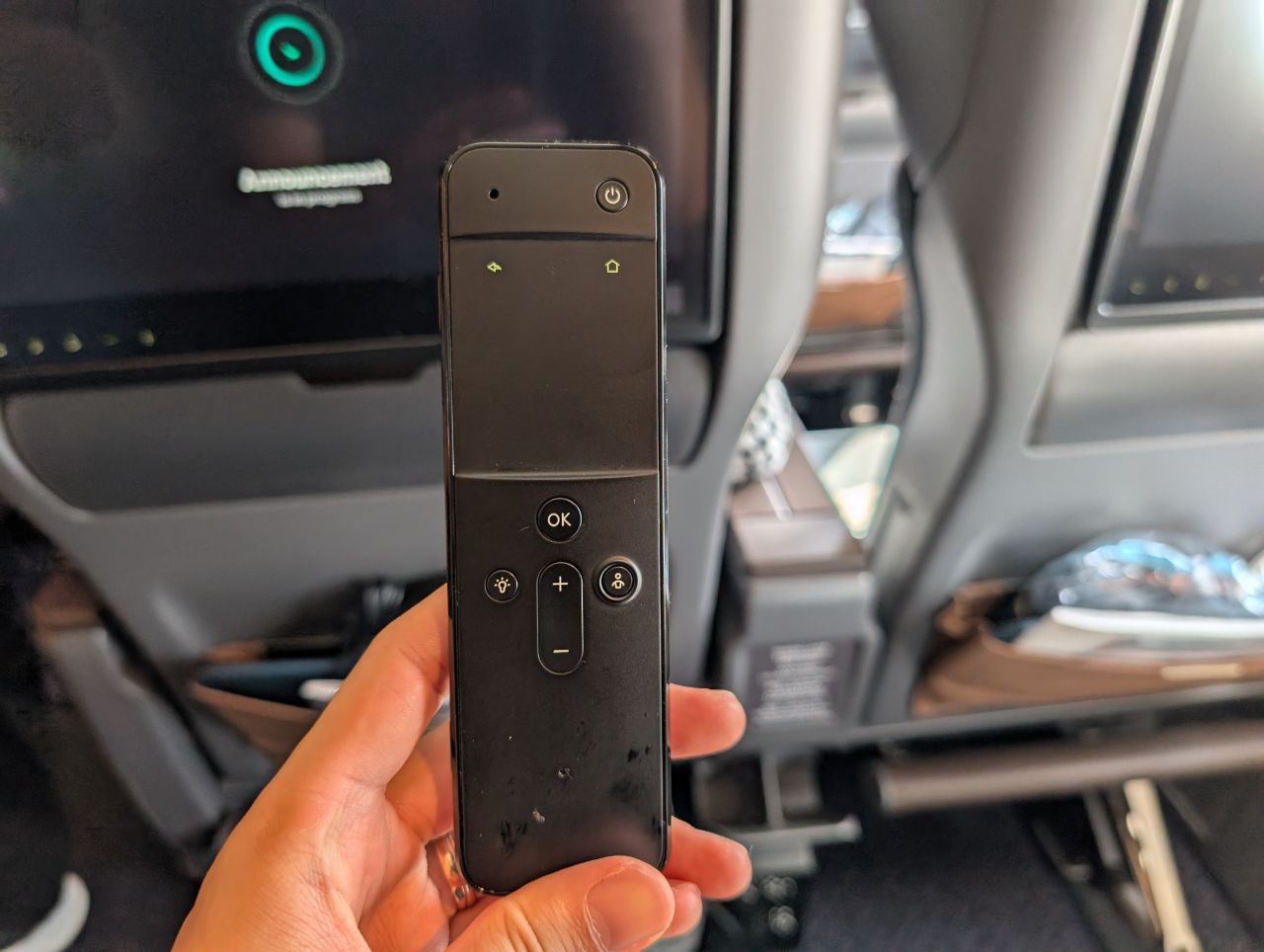
These Premium Economy seats do not offer wireless charging (though I have serious doubts about the utility of inflight wireless charging in general, at least until the technology improves severalfold). However, each passenger has a universal power outlet and a Type-A and Type-C charging port. Do note that the Type-C port maxes out at 45W, so those with laptops requiring 60W charging will still need to bring a power brick for full speed charging (in Business Class, USB-C outlets offer 60W).
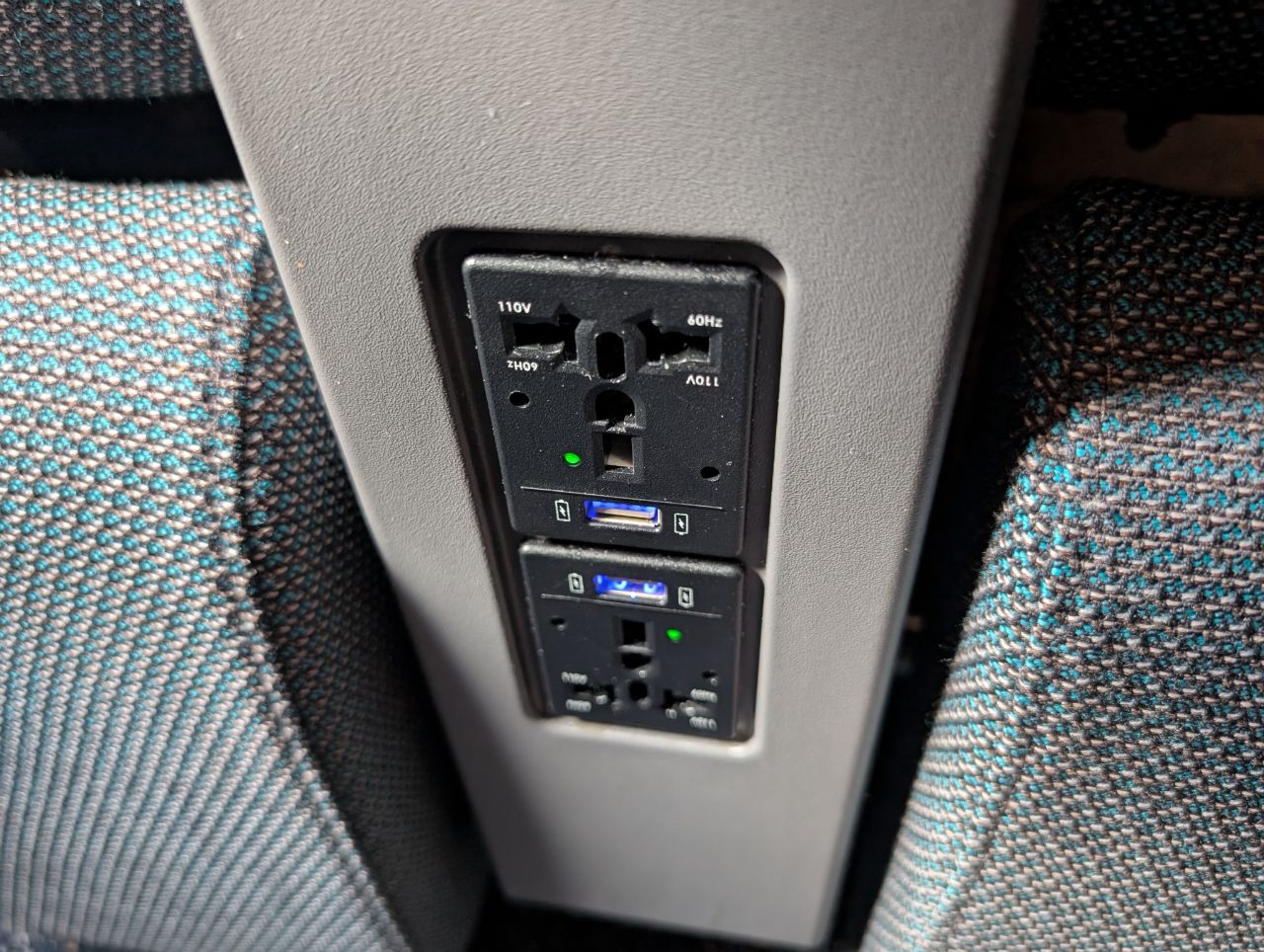
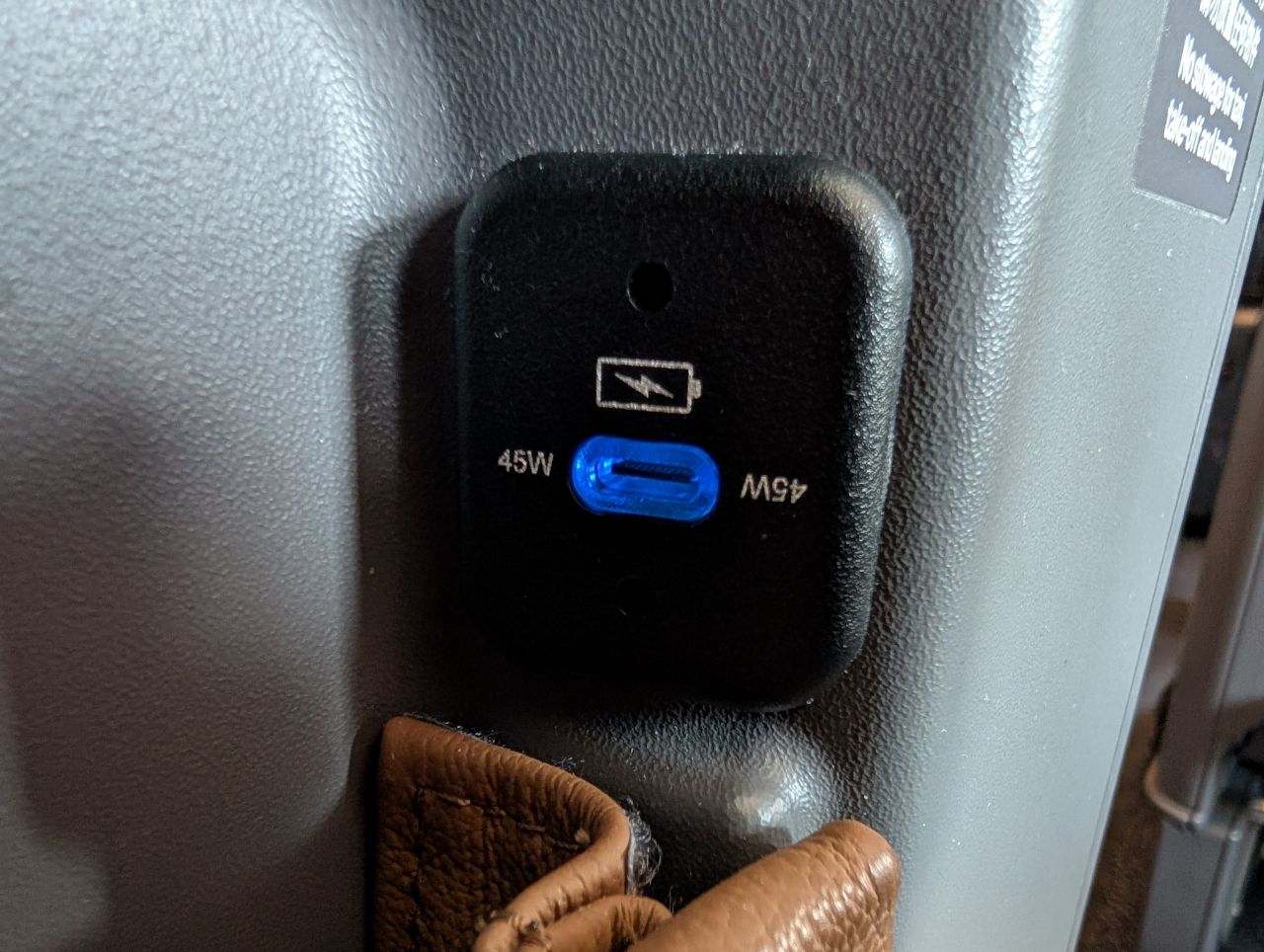
The tray table pops out from the center armrest, much like Economy Class seats of old.
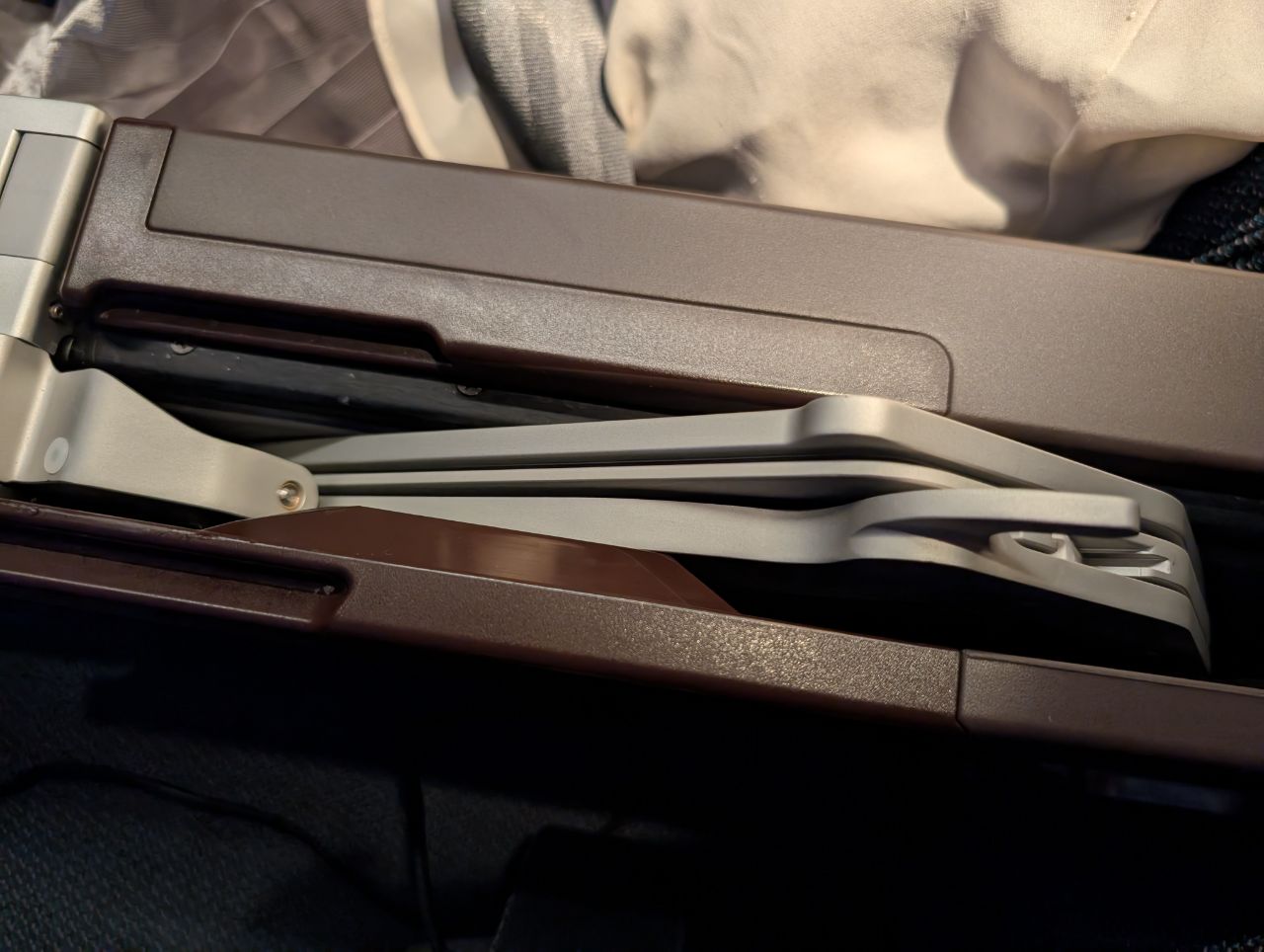
The mechanism is spring-loaded, and you need to press a button to release the lock and pull it out. This might just be an issue with my particular seat, but I did have difficulty getting the tray table back into its storage area as the lock wouldn’t engage, resulting in the centre armrest popping up awkwardly.
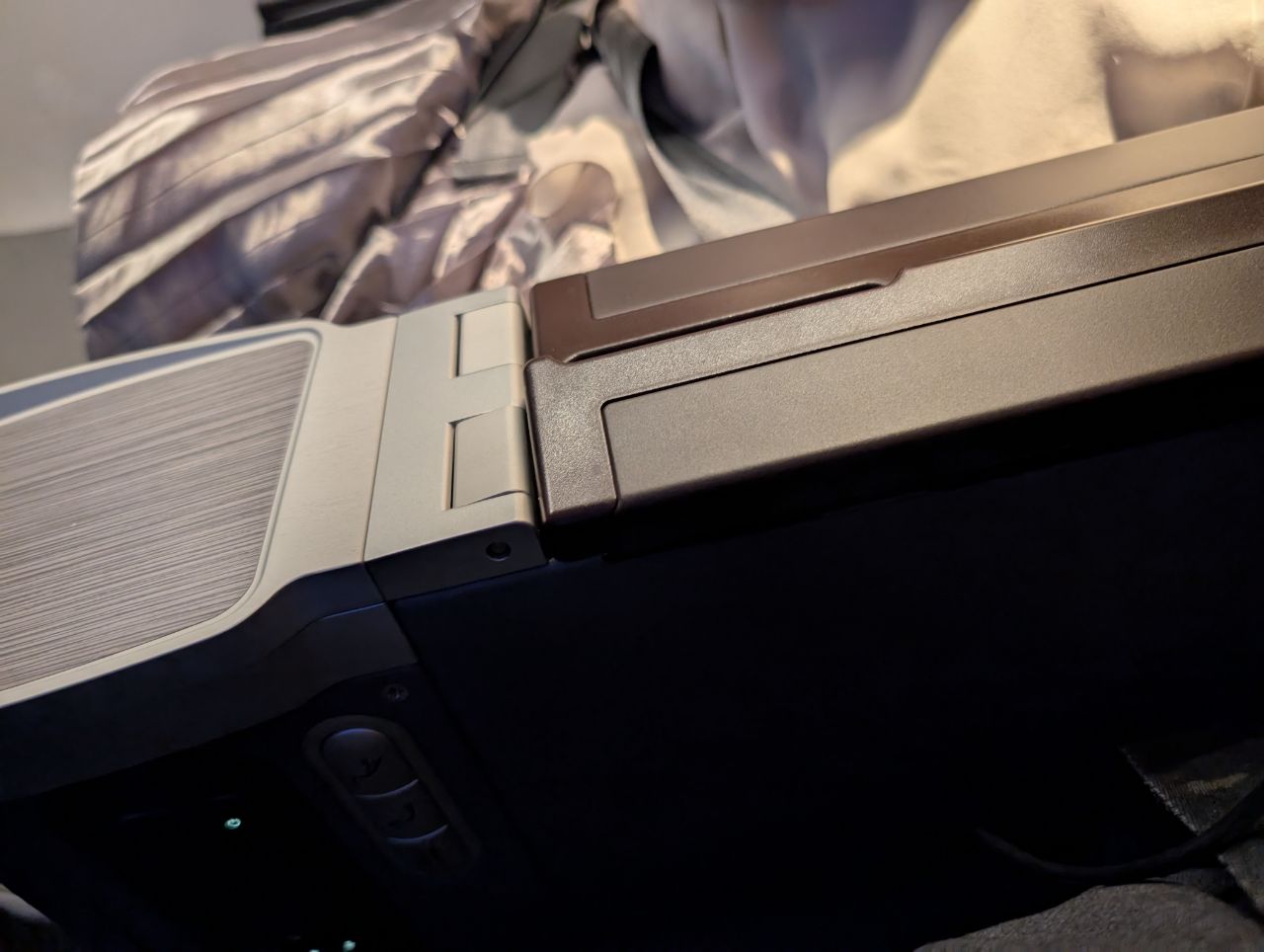
The bifold tray table could comfortably fit my 14″ Lenovo X1 Carbon laptop, though there was a little bit of bouncing when typing. To be fair, I haven’t had a Premium Economy seat that offers a bounce-free typing experience; that kind of solidness can only be found in Business Class.

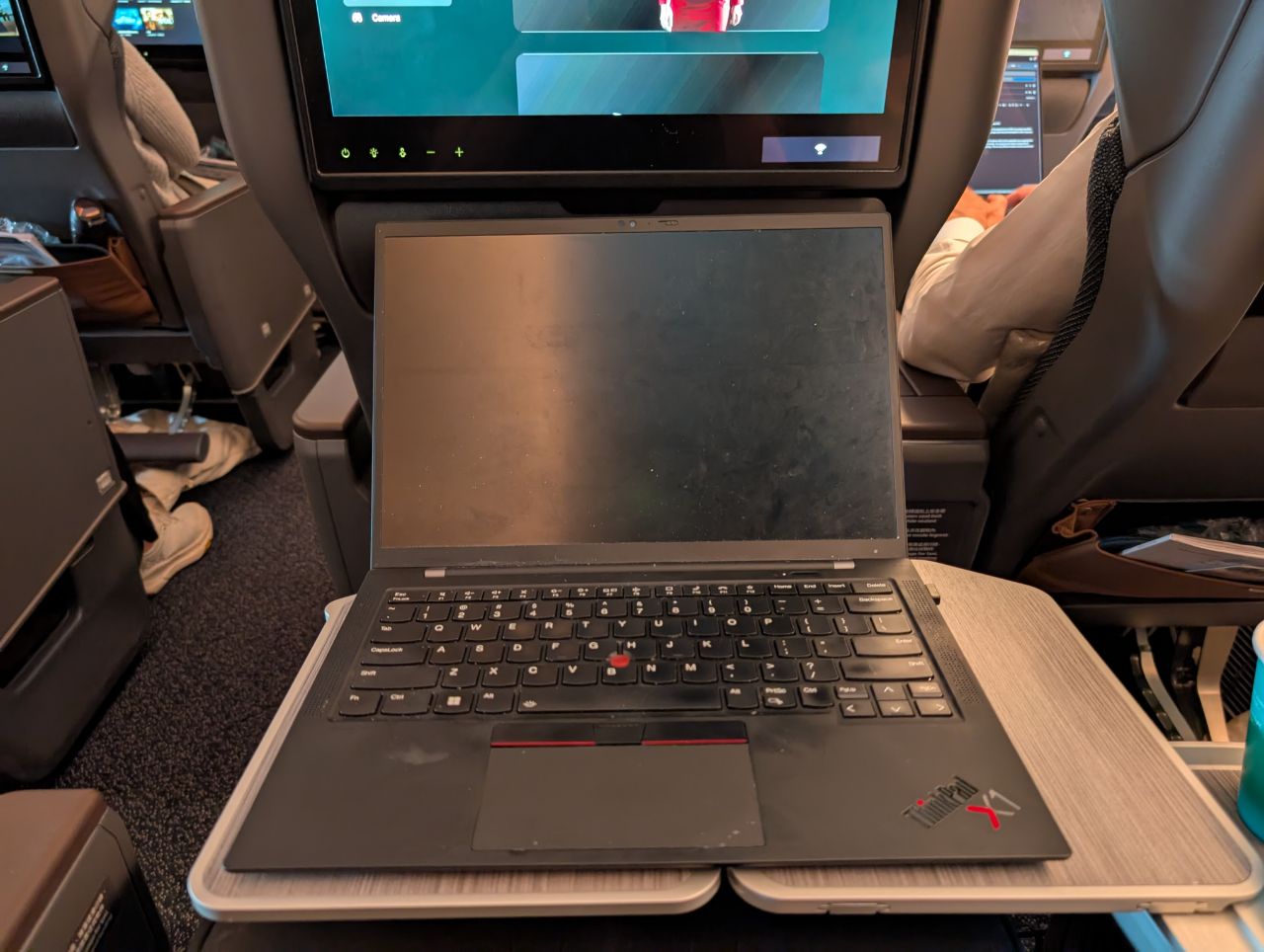
With a laptop deployed, there won’t be any room for drinks (nor will you want them so close to your electronics), but you can make use of the cocktail tray between the seats.
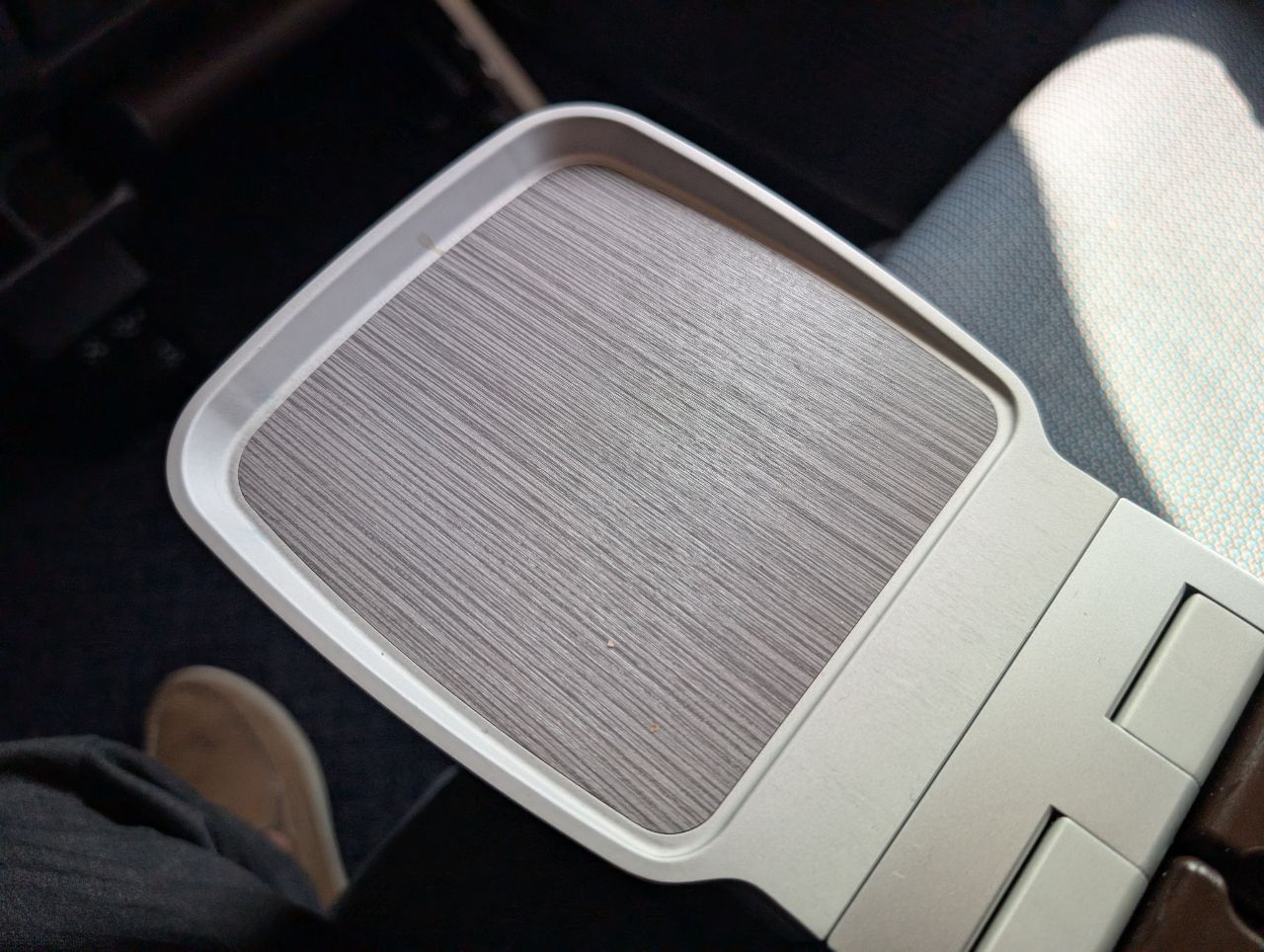
Now, let’s talk seat recline. Cathay’s new Premium Economy seats have a very generous 8 inches of recline, which is perhaps a bit too generous. When the seat in front is reclined, it becomes difficult to have your meal, or even work on your laptop.
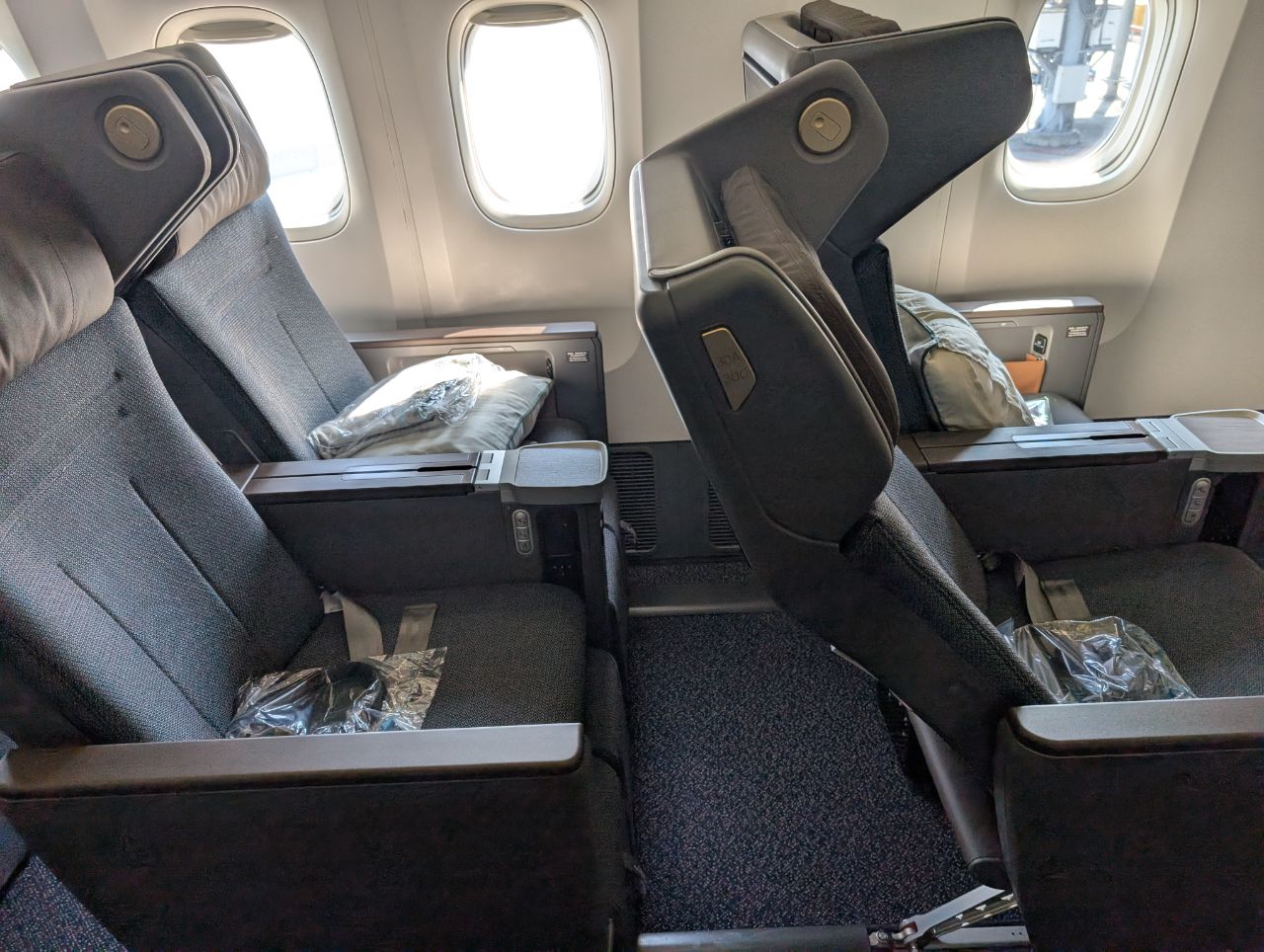
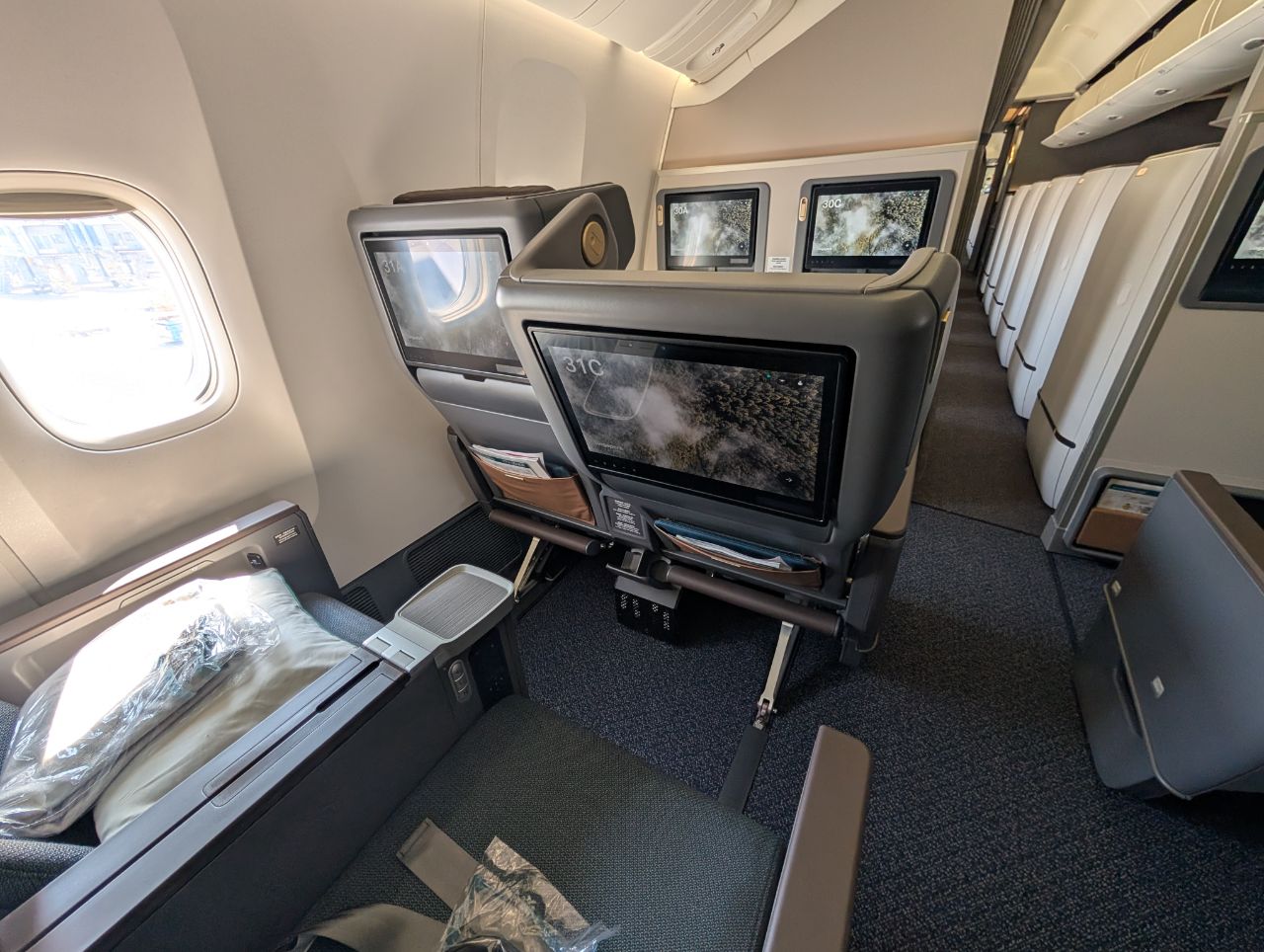
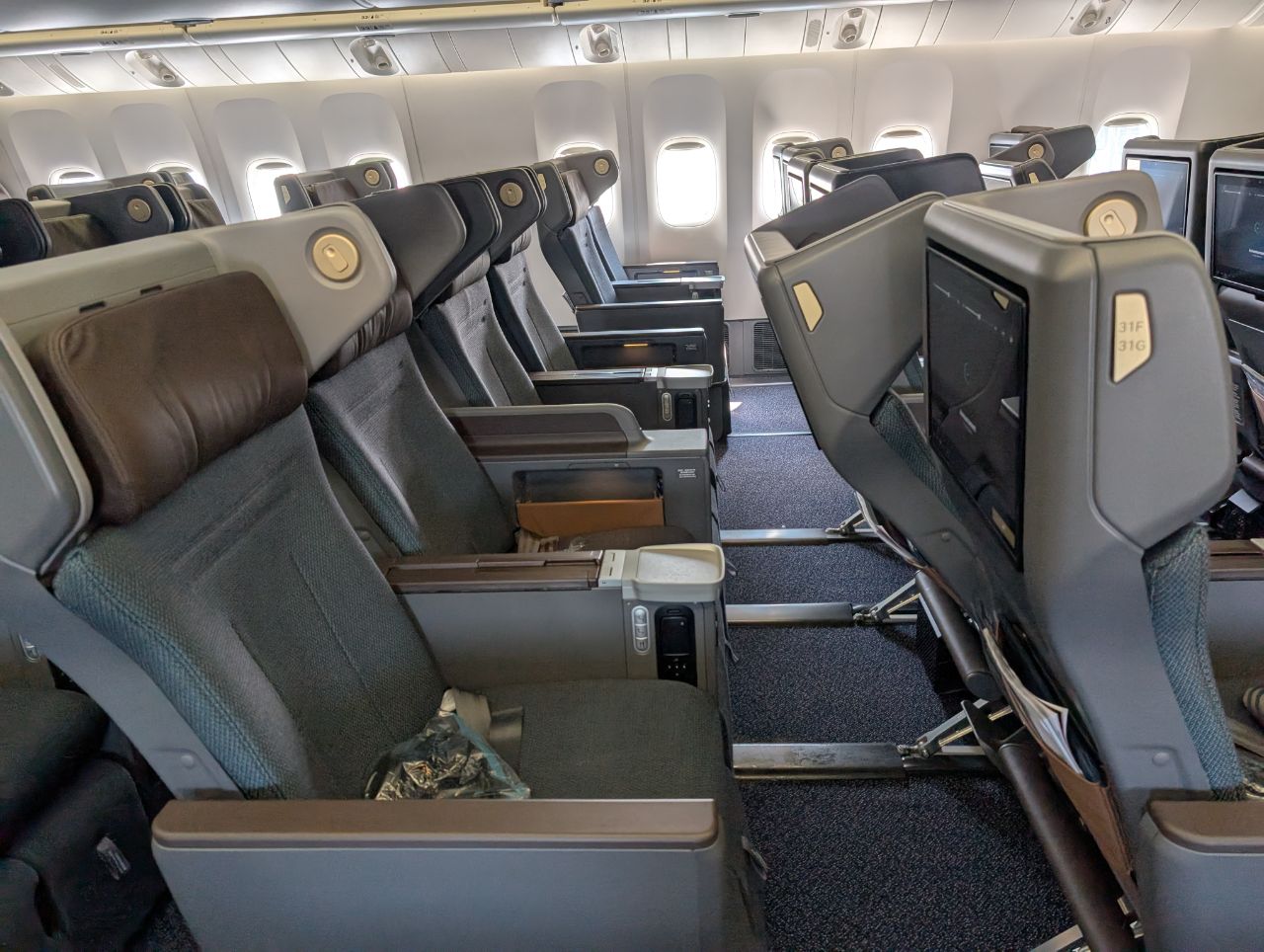
The photos below illustrate the “pinching” effect that happens when the forward passenger is in full recline.

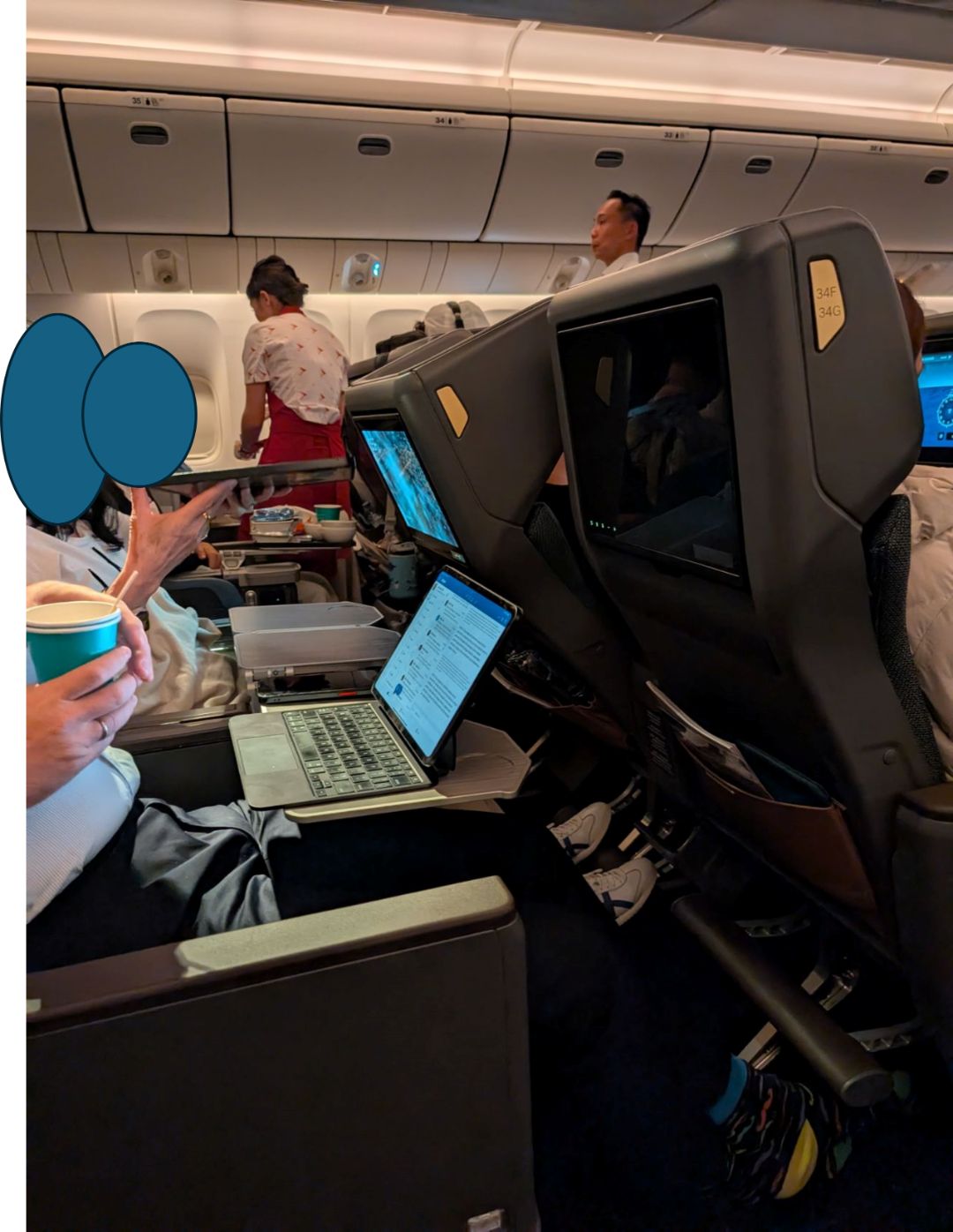
The problem is especially acute if you’re not in an aisle seat, because you have to contort yourself at a strange angle to egress. You feel like you have to simultaneously lean backwards (to avoid the recline of the forward seat) and forwards (to step over the legs of the aisle passenger).
If this bothers you, you’ll definitely want to pick a seat in the bulkhead row. But I decided to pick the very last row in the cabin, so I could recline as much as I wanted without complaints. You aren’t robbed of any recline in the last row, in case you were worried.
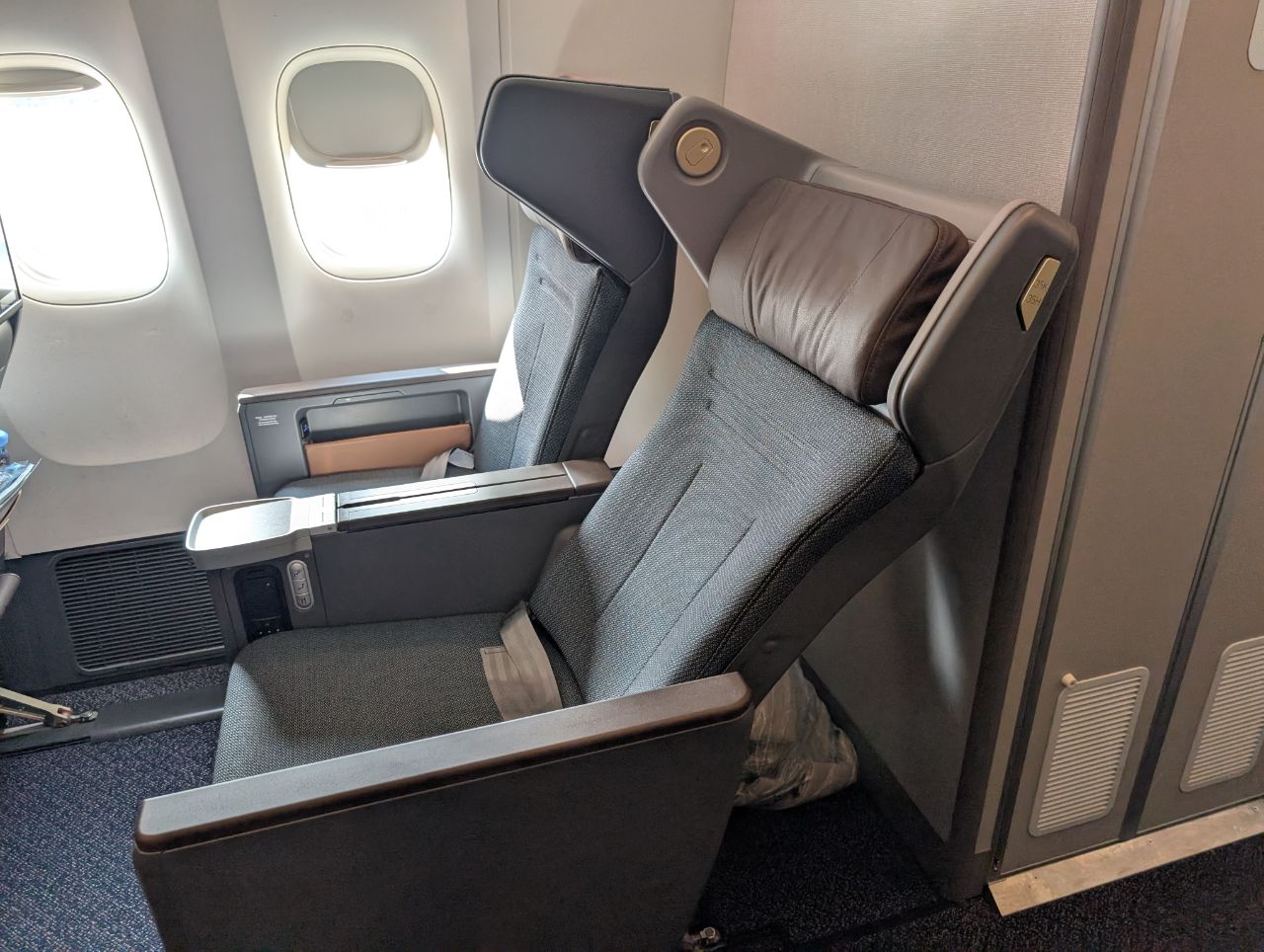
Over the course of my 3.5 hour flight, I caught up on some work, took a meal and then had a brief nap. I found the seat performed well in all three situations, with the well-padded seatback a welcome change from slimline Economy seating.
Food & Beverage
No pre-departure drinks were served in Singapore, though I understand these are the norm for long-haul Premium Economy flights.
While Cathay Pacific’s First and Business Class passengers can pre-order specific meals through the Choose My Meal platform (think of it like Singapore Airlines’ Book The Cook), there’s no equivalent for Premium Economy.
More surprisingly, there’s also no menu provided, whether physical or digital. While you can find a sample menu for Premium Economy online, Cathay does not currently provide route-specific menus (edit: physical menus are provided on long-haul flights, per the comments). Contrast this to Singapore Airlines, which publishes menus for all cabins eight days in advance. I find this a useful feature, because if I don’t like what’s being served, I can then order a special meal instead.
On this flight there was a Western or Asian choice. I went with the latter, which turned out to be pork with rice, served with a small salad, bread roll, garlic bread, cut fruits and Haagen Dazs ice cream.
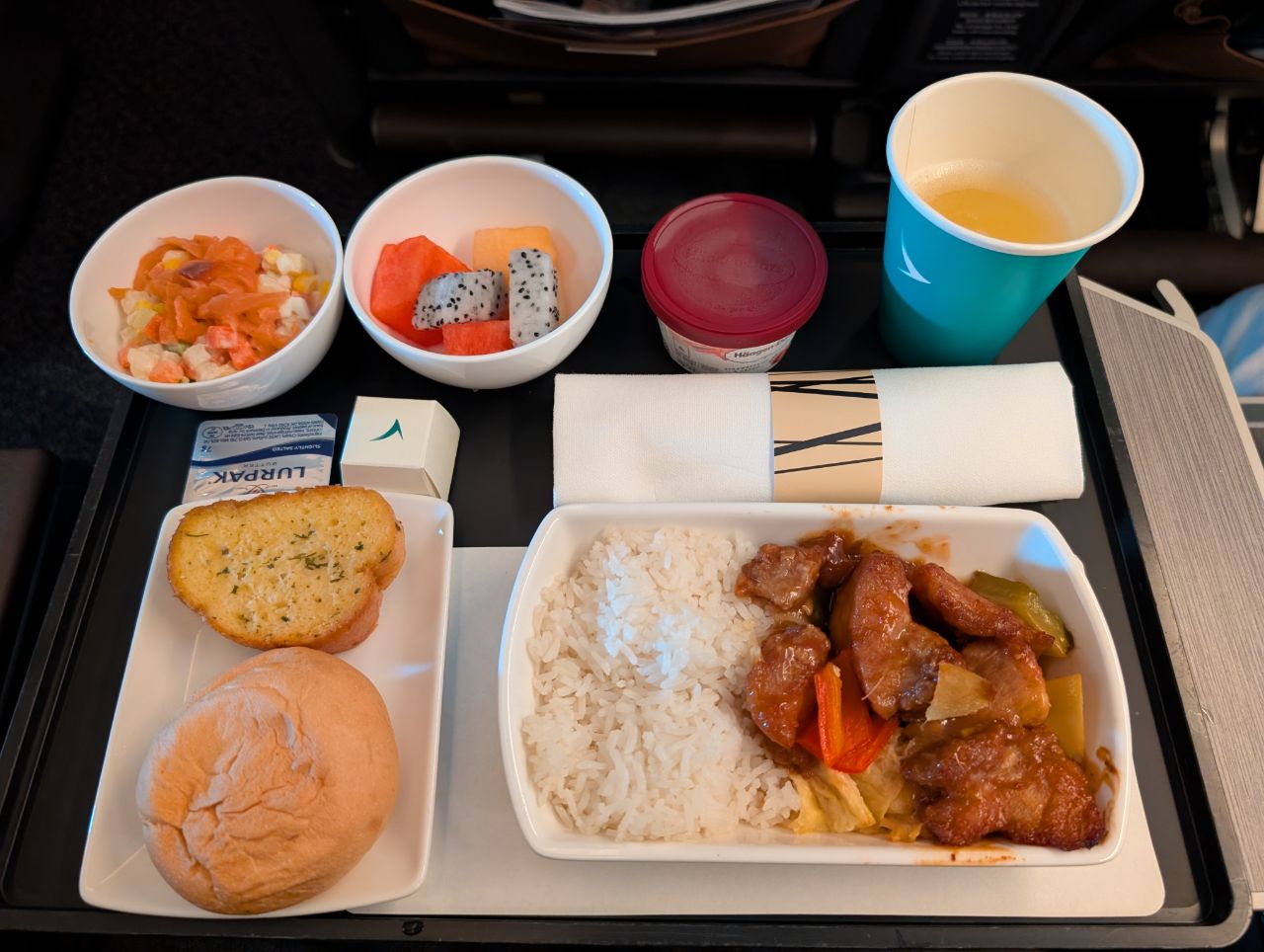
The food quality wasn’t great, to be frank, and this meal was little different from what you’d get in Economy Class- except for the Haagen Dazs and prosecco, served in a paper cup. Cathay doesn’t offer champagne in Premium Economy, though that’s par the course for most airlines (Singapore Airlines does offer Charles de Cazanove champagne however) .
Speaking of drinks, Premium Economy passengers can chose from the following:
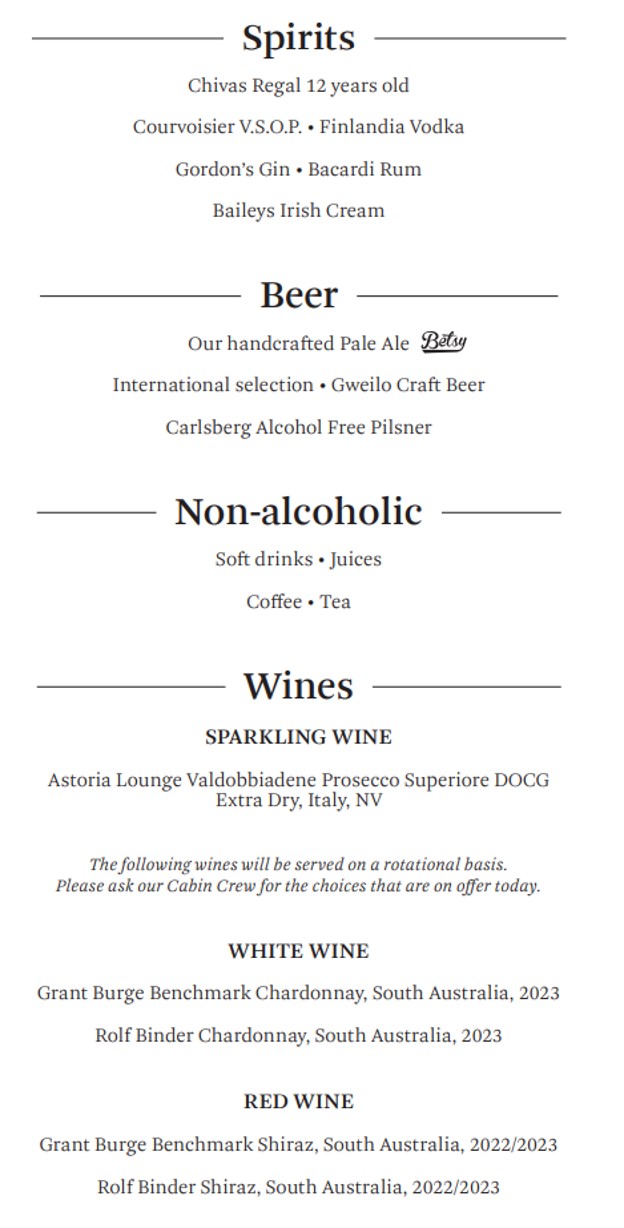
Inflight Entertainment
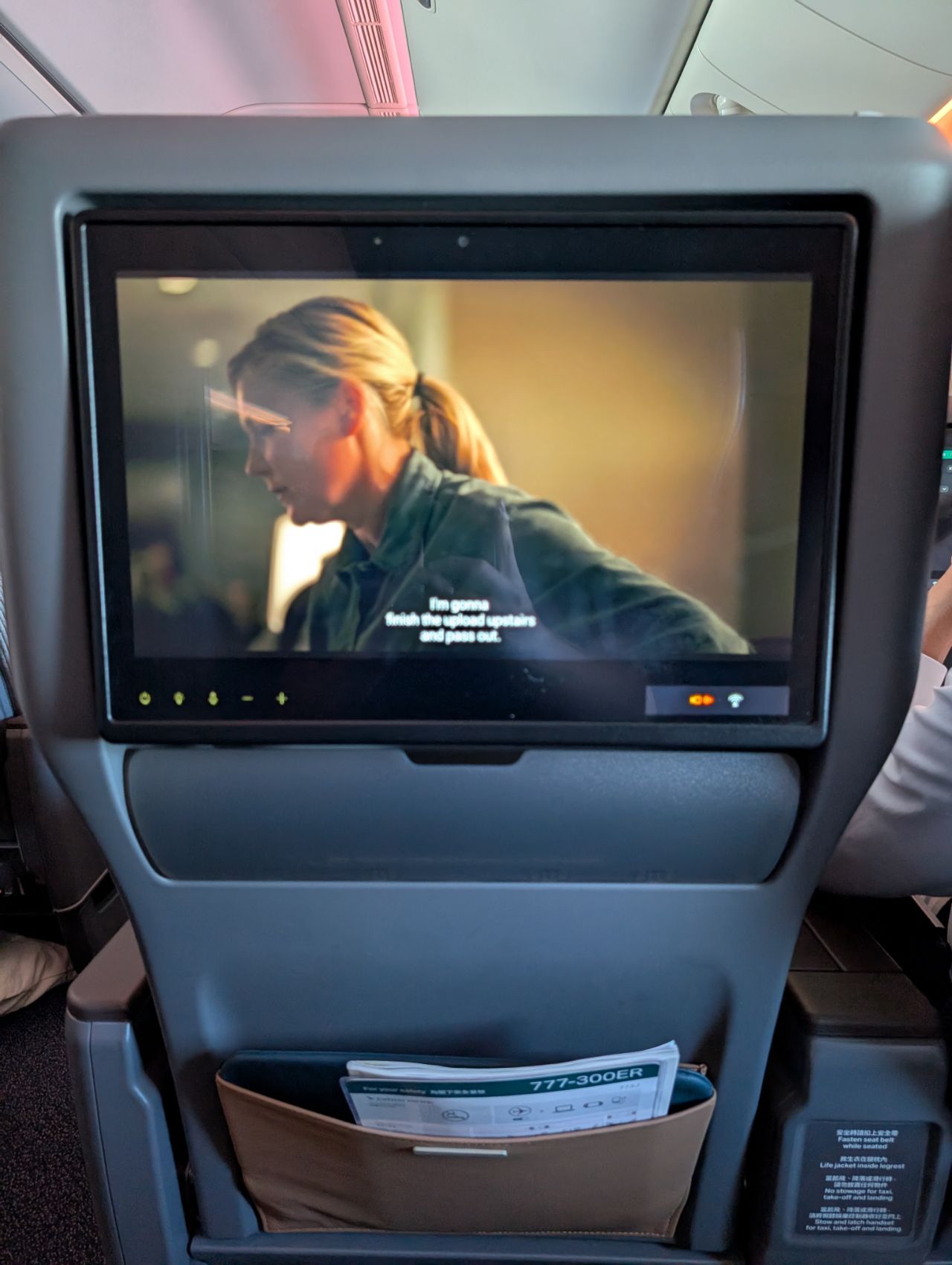
Premium Economy Class passengers can enjoy their inflight entertainment on massive 15.6 inch screens with 4K resolution. For perspective, this is 85% the size of a Singapore Airlines Business Class screen, and much higher resolution. I found the screens to be responsive to touch inputs, with hardly any lag.
I’ve previously written about the 4K problem facing airlines, in that technology is outstripping content. There’s no point having 4K screens when the majority of media is still encoded in 480p (DVD quality). On an ANA flight back in 2019, the only 4K content to watch on its lovely 4K screen was a tech demo!
And since content provides charge a premium for 4K media, many airlines resort to upscaling lower resolution media into 4K using the IFE system. But 480p has 4% the pixels as 4K, and there’s no software on earth that can magically fill in the remaining 96%. Therefore the images look terrible, with plenty of motion blur and pixellation.
That’s why I was delighted to see an entire library of 4K content available in Studio CX.
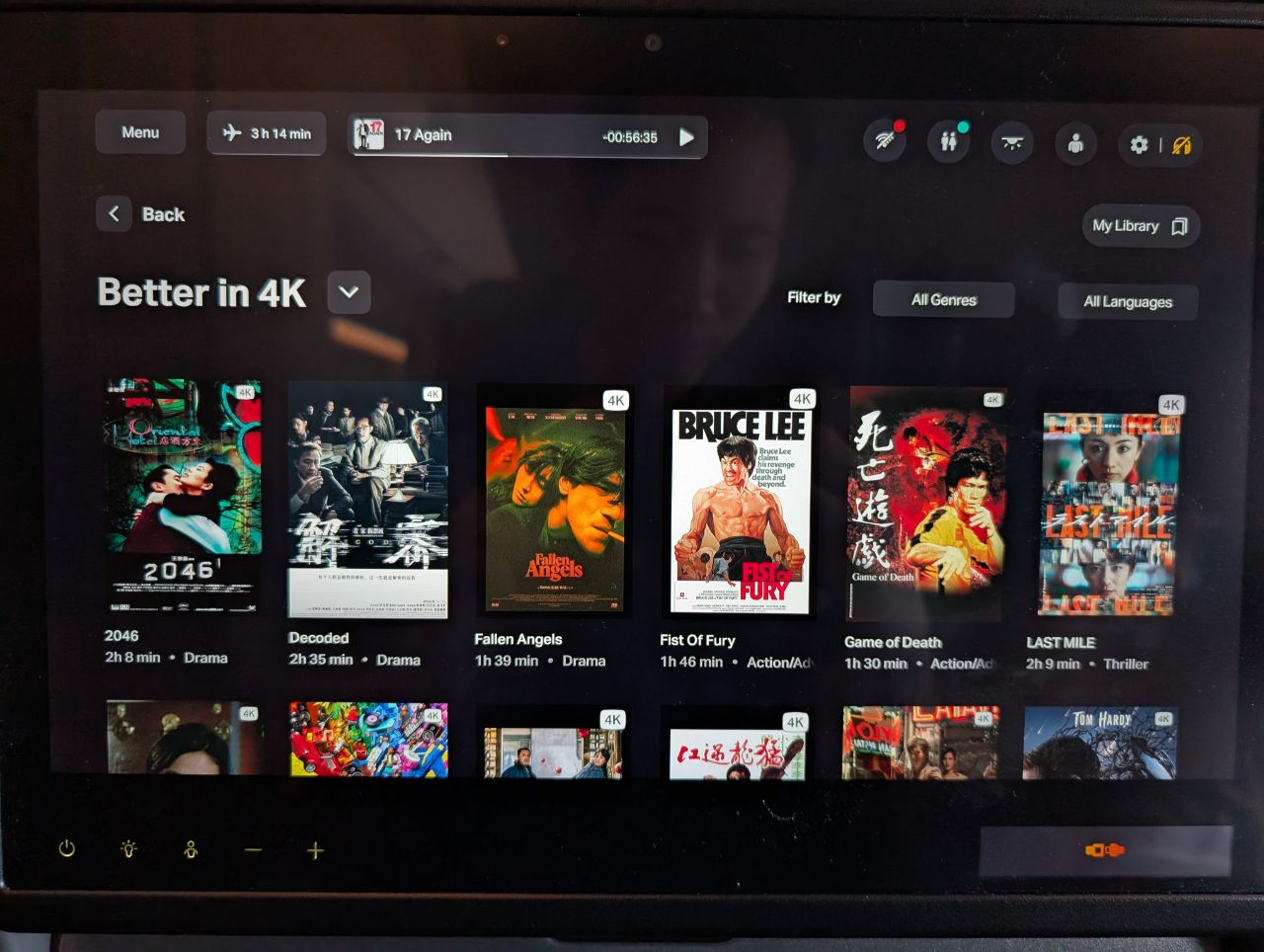
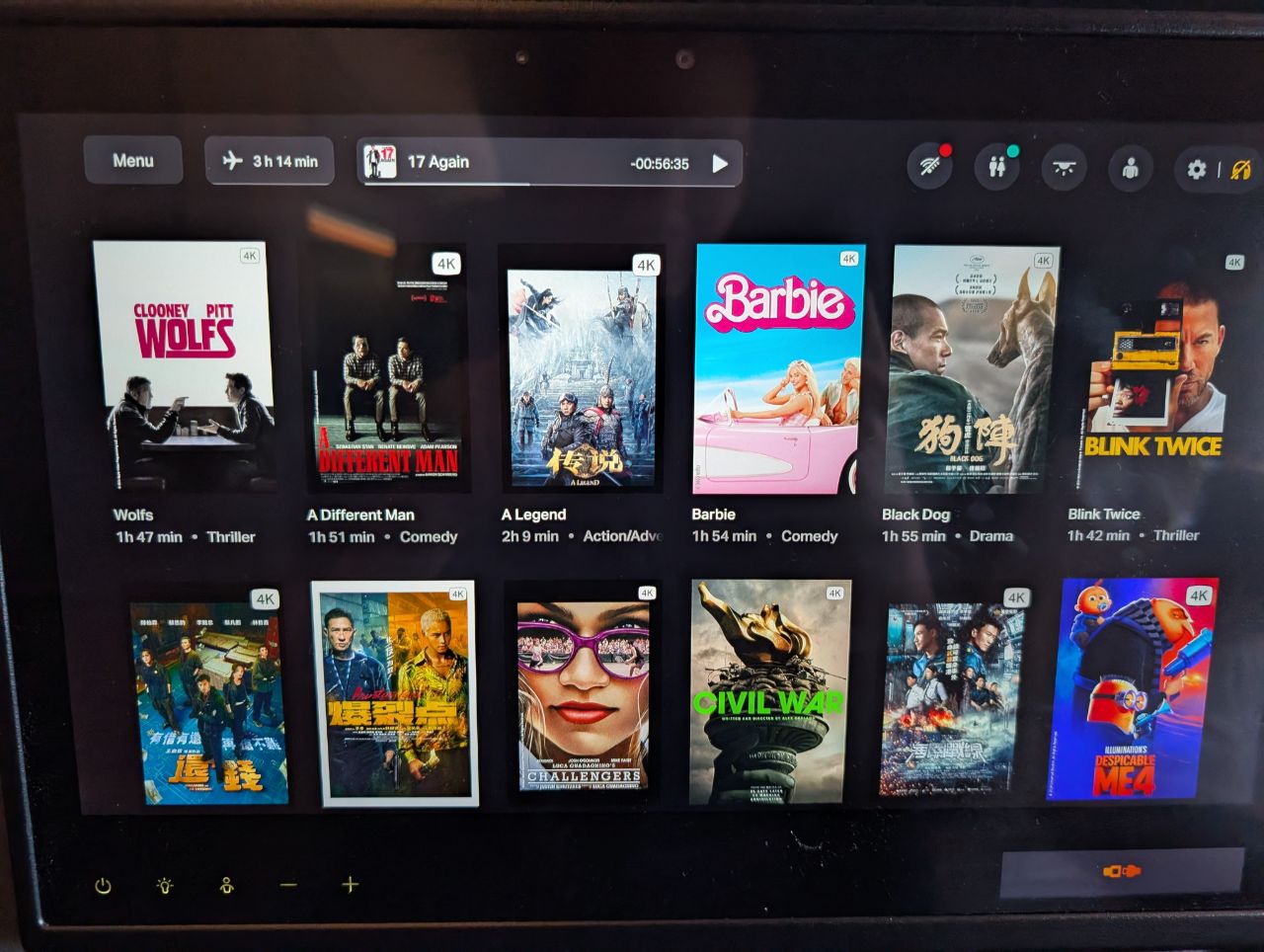
The picture quality was stunning. When I watched Civil War, it was like I was seeing the fall of the United States unfolding before my eyes!


The 4K screen also makes it a joy to use the forward and downward cameras, giving a crystal clear view of the tarmac and other airplanes (I understand that Cathay upgraded the cameras as well during the refit). Watch this during take-off or landing; it’s better than any movie in the selection!
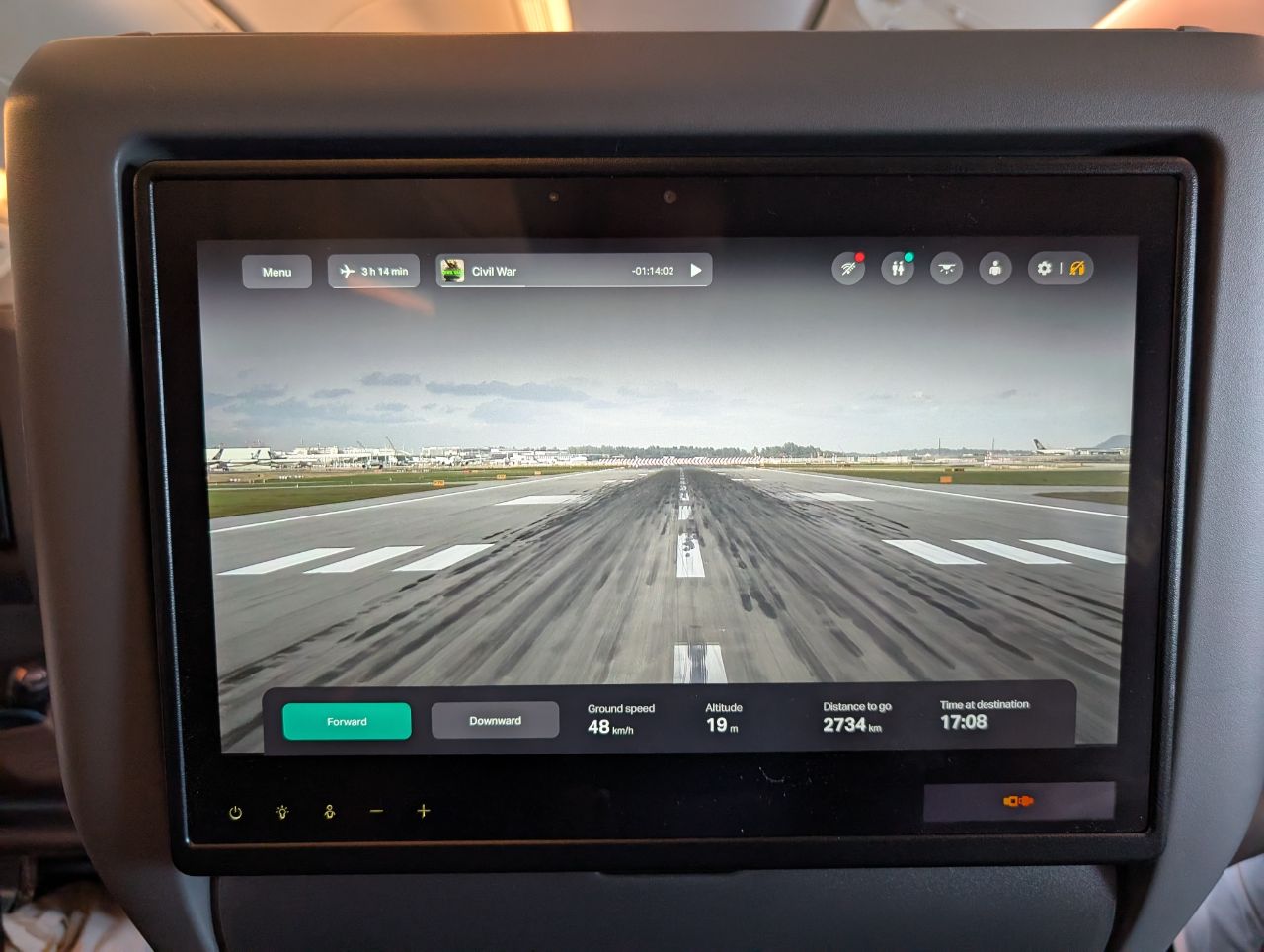
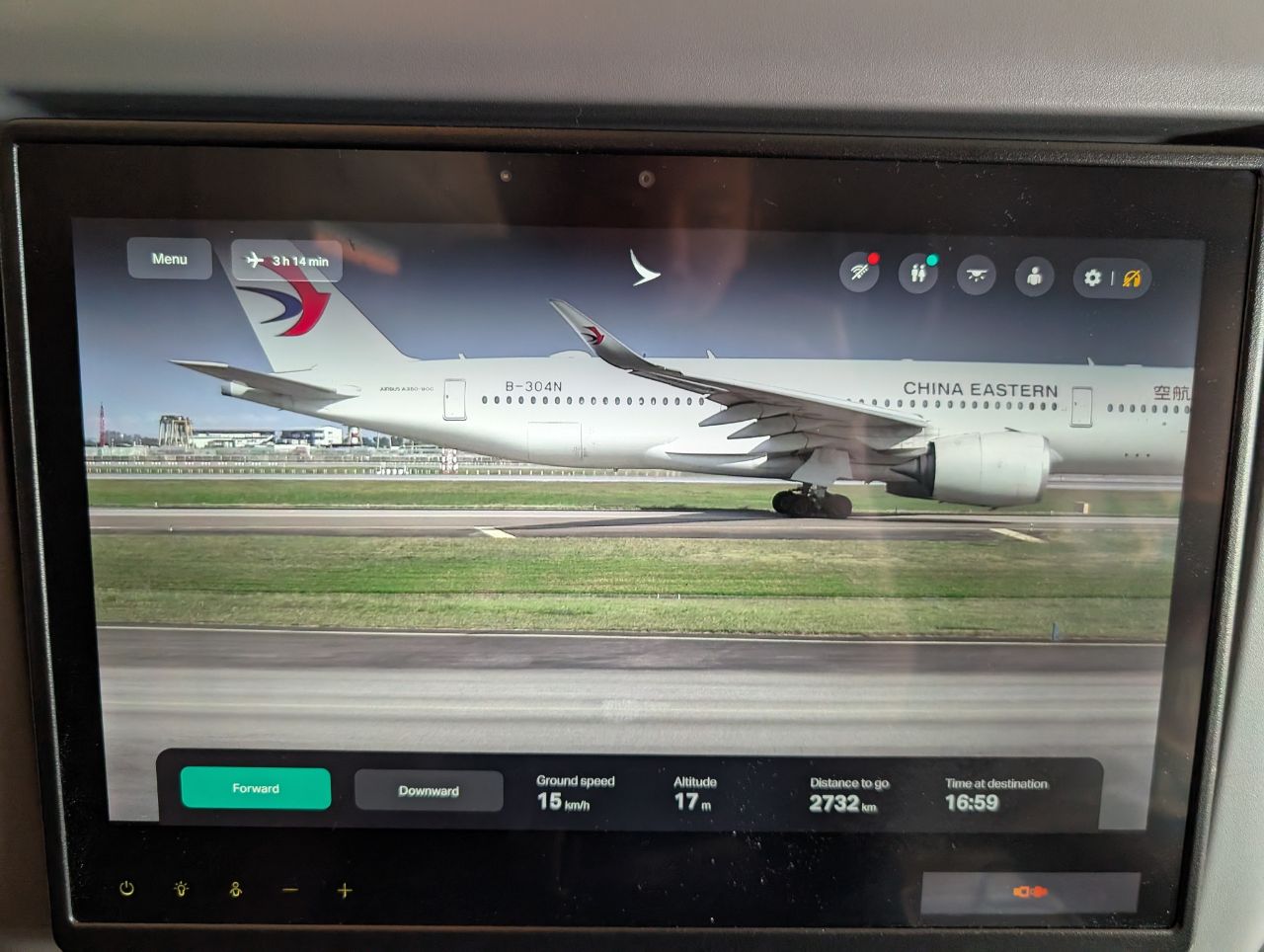
Noise-cancelling headsets are provided to Premium Economy passengers. These sit over your ear for better noise isolation (other airlines do on-ear headphones, which perform much more poorly).
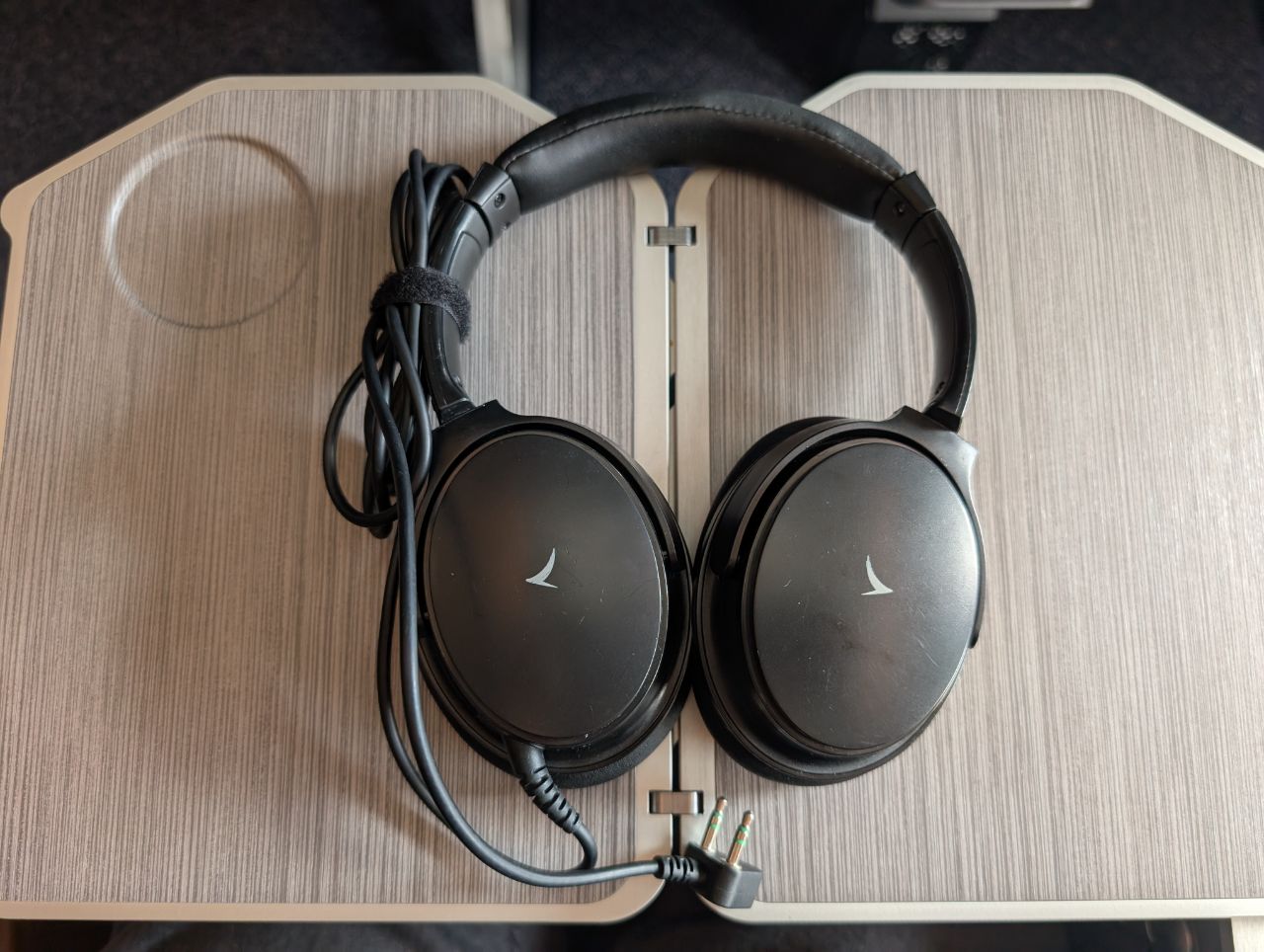
But a far better option is to pair your own headphones, which can be done through the system’s Bluetooth connection. The pairing process was very simple: just put your headphones in discover mode, tap on the menu, and the pairing happens seamlessly. I could even use the buttons on my Beats Fit Pro to pause the movie, useful whenever the cabin crew came around.
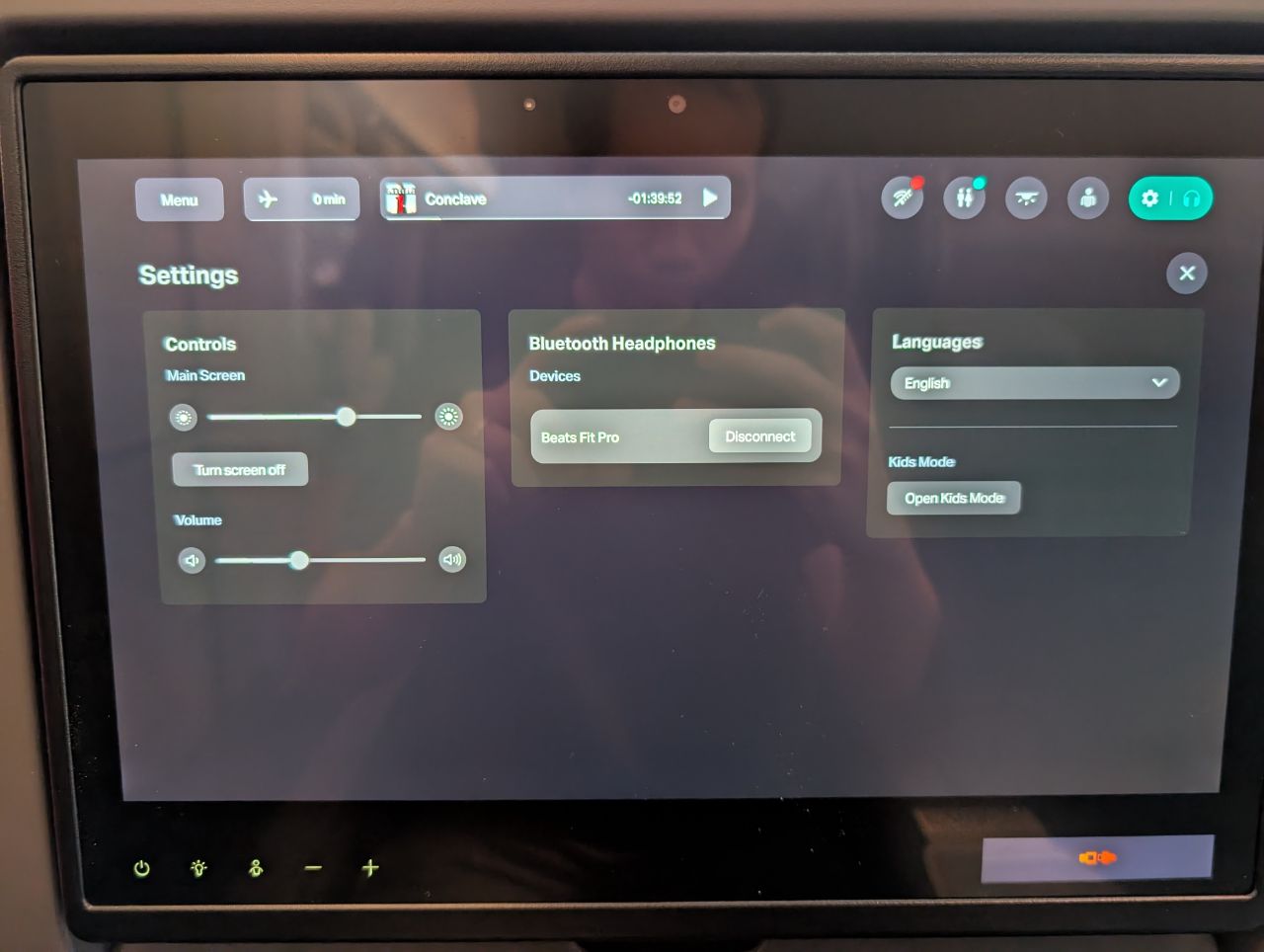
Wi-Fi
Cathay Pacific offers inflight connectivity on all its Airbus A350 and A321neo aircraft, and most of its Boeing 777 and Airbus A330 aircraft.
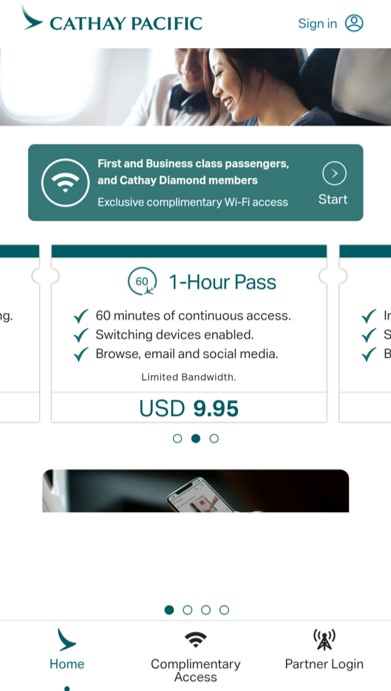
Access is free for Cathay Diamond members, as well as First and Business Class passengers. Everyone else will need to buy a Wi-Fi package.
| 📶 Cathay Pacific Wi-Fi Pricing | |
| Duration | Cost |
| Message Pass (≤6 hours) |
US$3.95 |
| 1-hour Pass | US$9.95 |
| Unlimited Use (≤6 hours) |
US$12.95 |
| Unlimited Use (>6 hours) |
US$19.95 |
I managed to get respectable speeds of 8 Mbps down and 3 Mbps up during my flight. It can’t beat Starlink, of course, but this was more than sufficient for getting work done and replying to emails.

Lavatories
On many carriers, including Singapore Airlines, Premium Economy and Economy passengers share the same lavatories.
However, when introducing its new Premium Economy cabin, Cathay specifically emphasised that passengers could look forward to two dedicated lavatories.
Our new Premium Economy cabin boasts two dedicated lavatories – one on each side of the aircraft – equipped with touch-free features to minimise contact, ensuring your peace of mind.
-Cathay Pacific
Two lavatories for 48 passengers would be a ratio of 1:24, much better than the 1:45 in Economy Class.
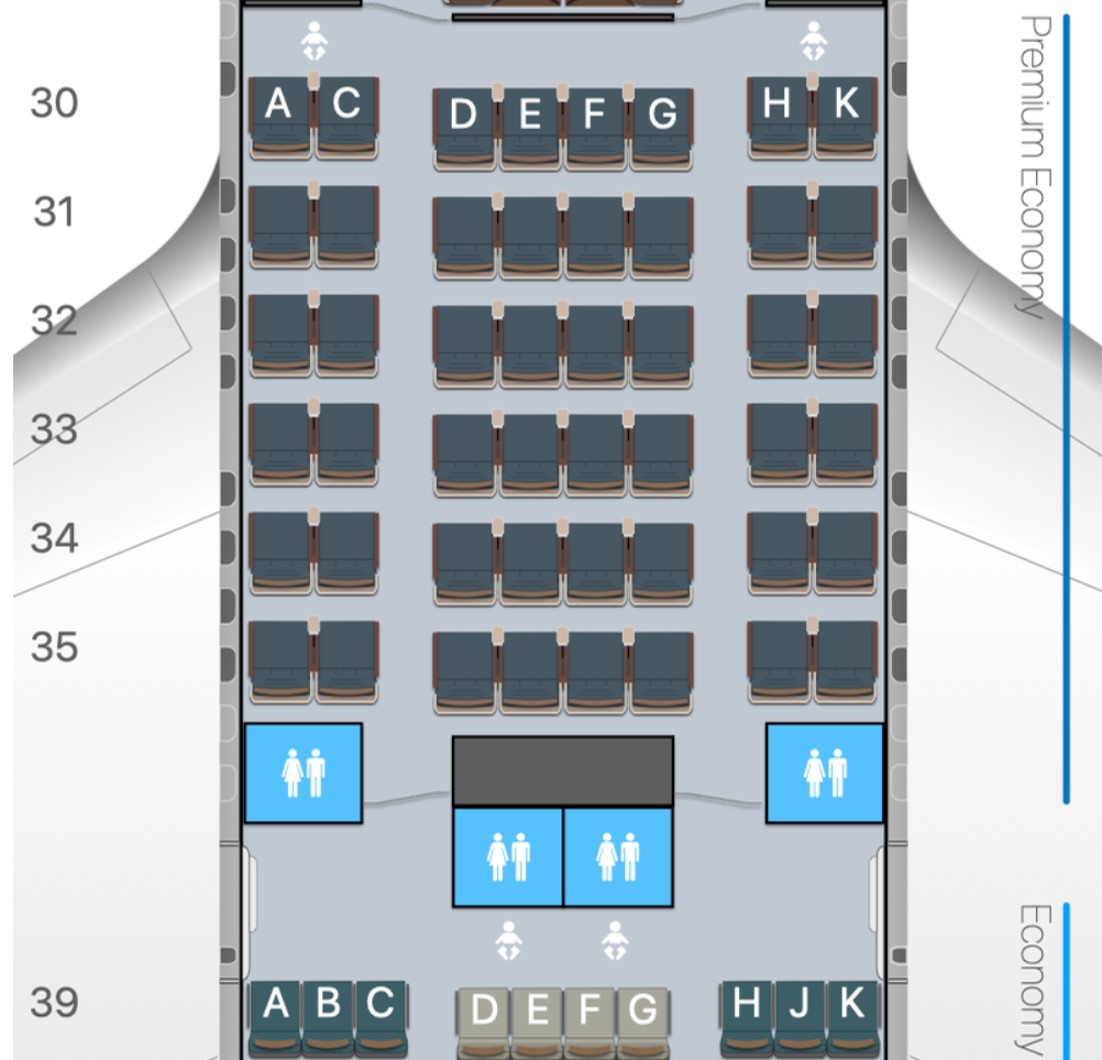
But that’s not what I encountered on my flight. The lavatories are located to the rear of the Premium Economy cabin, and in theory, the one on the left (facing the rear) is meant for Premium Economy passengers, while the one on the right is meant for Economy passengers. I assume that the curtain is supposed to be drawn to partition the sections, but it remained open the entire flight. This led to situations, especially closer to landing, where there was a queue to use the lavatories.

Maybe Cathay has different protocols on long-haul flights, but on this route at least, the Premium Economy cabin did not have the advertised dedicated lavatories.
Another fun feature is the so-called “lavatory occupancy checker” (available in all cabins, of course), which allows passengers to see which lavatories are currently in use. It’s a novelty, no doubt, but I didn’t use it all that much as I’m so used to glancing at the overhead display showing whether the lavatories are available.
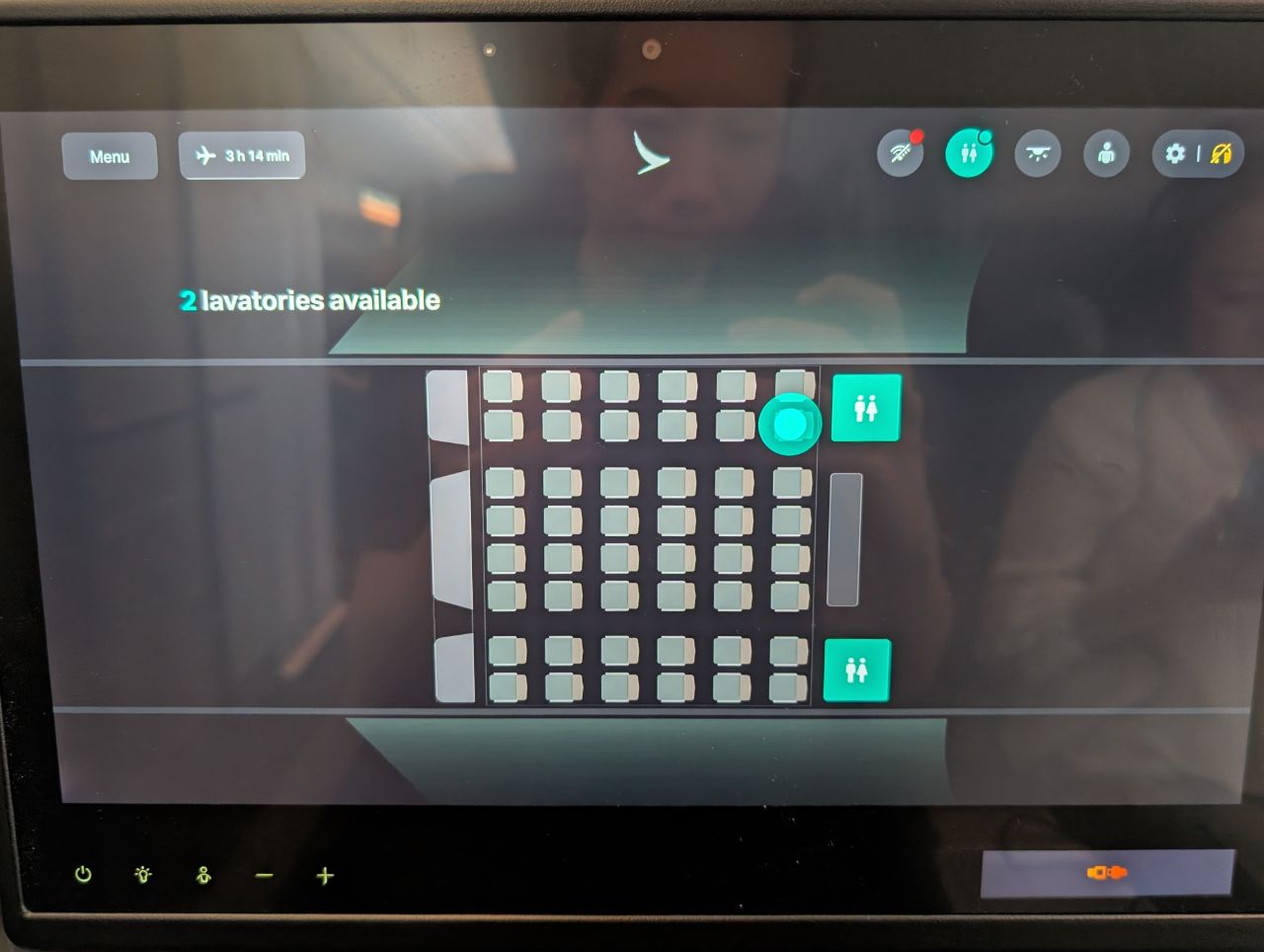
As for the lavatories themselves, they were kept clean and had touch-free taps and flushes (having a touch-free bin would be nice too!).
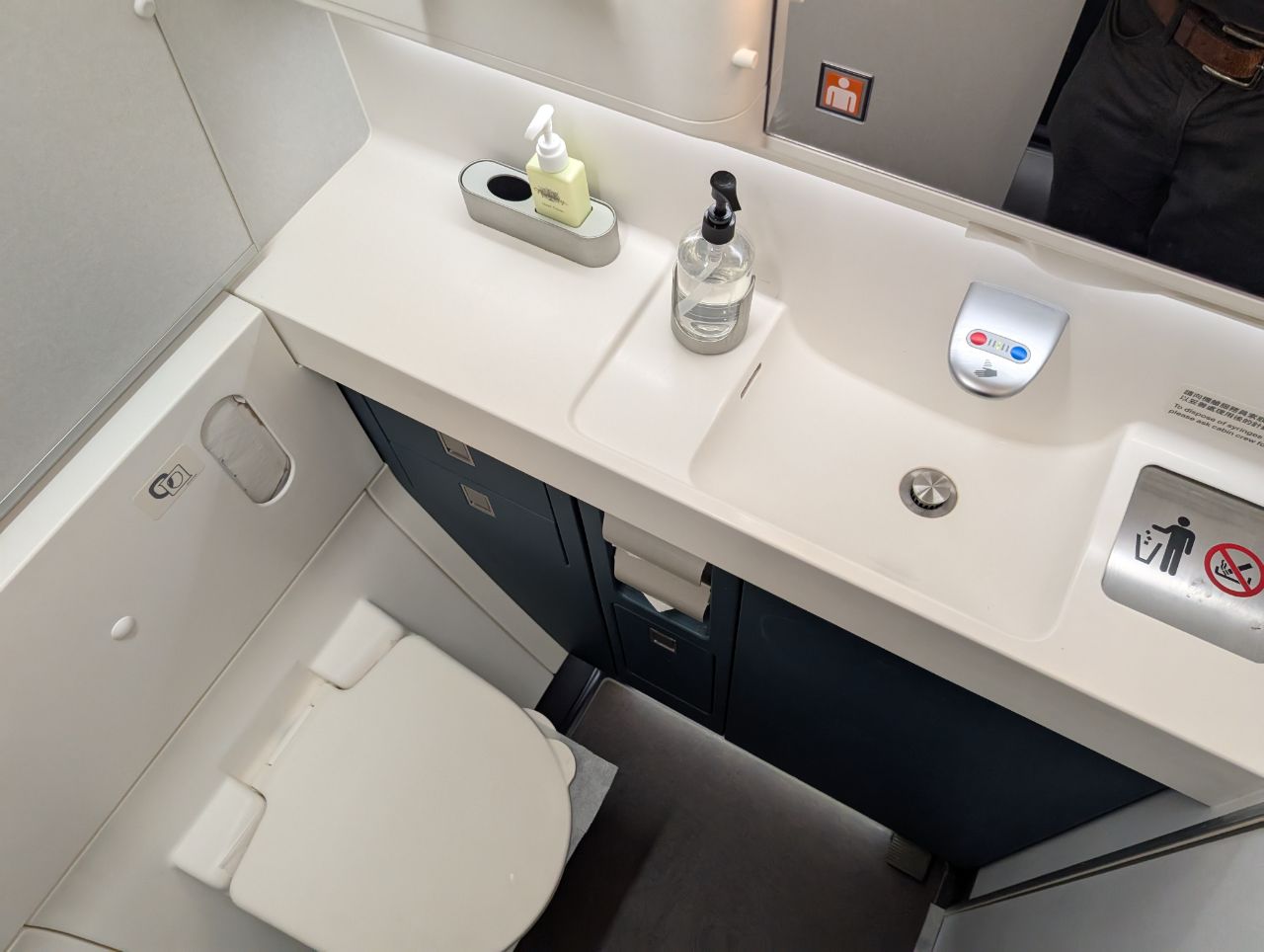
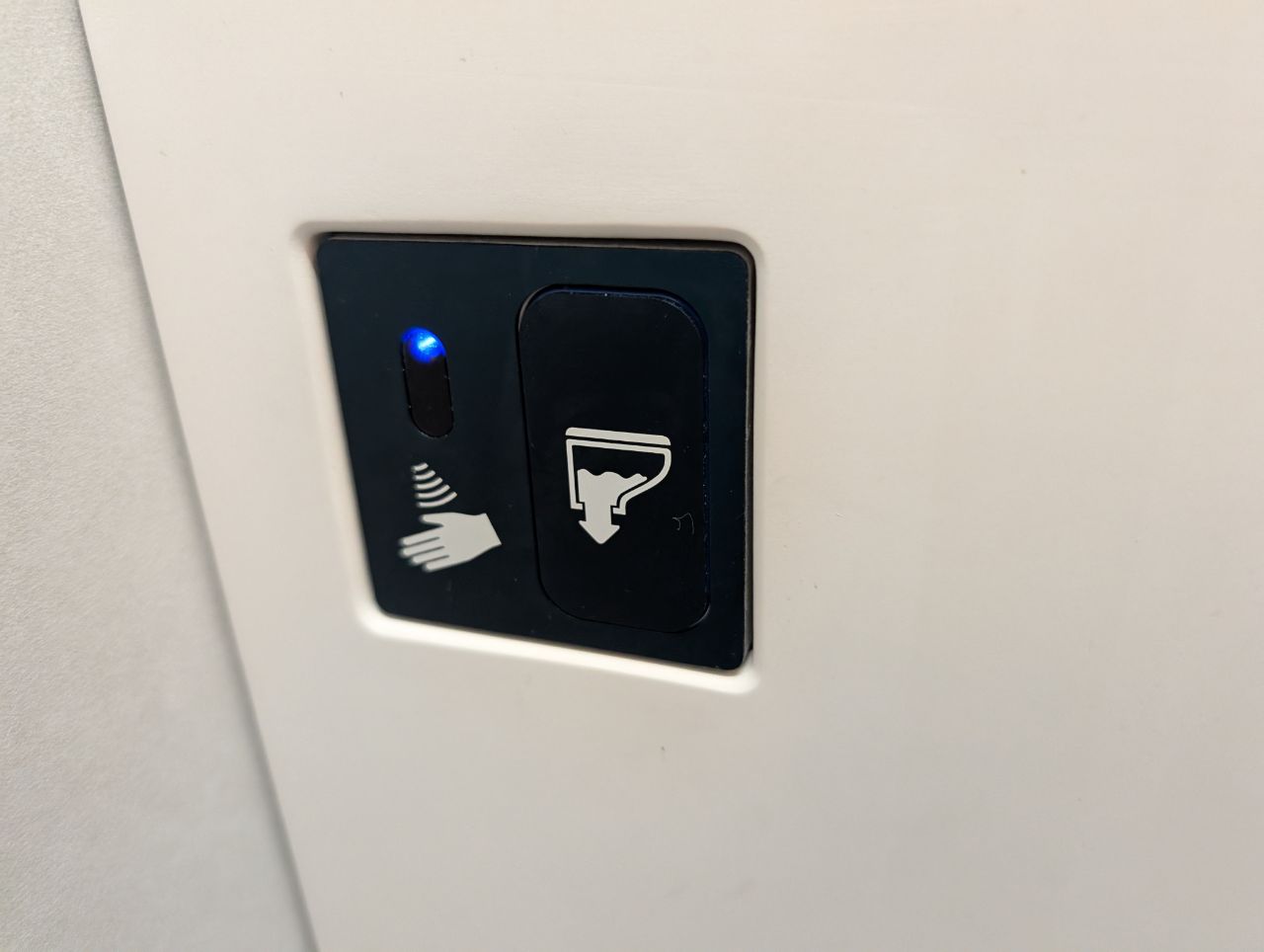
Conclusion
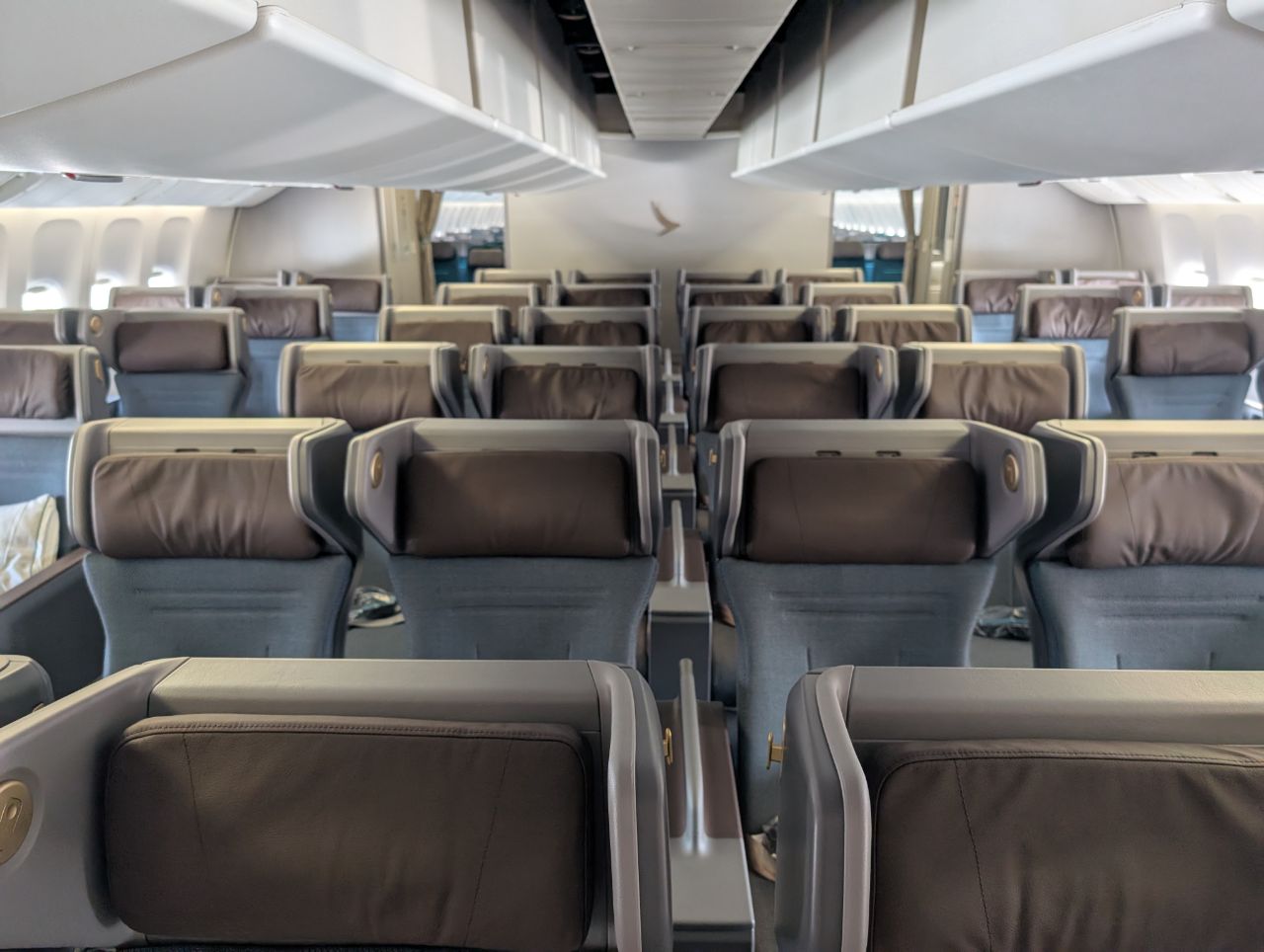
I came away very impressed by Cathay Pacific’s new Premium Economy Class, which is a big upgrade from the previous generation in terms of comfort, privacy and technology. It would have been easy to get an off-the-shelf solution, but Cathay has taken pains to customise these seats, and I think many of these touches will be even more appreciated on a long-haul flight.
The standout feature is no doubt those gorgeous 15.6 inch 4K screens, which make watching movies a delight. The ability to pair the system with your own Bluetooth headphones is great too, and will hopefully become a standard feature across more carriers in the near future.
Less impressive was the catering, which felt little different from an Economy Class meal with some sparkling wine. And if Cathay wants to use separate lavatories in Premium Economy as a selling point, it really needs to enforce that. Finally, the seat’s generous recline can be a double-edged sword, and your experience could very well depend on how considerate the passenger in front of you is.
All in all, I hope the B777-300ER retrofit progresses quickly, because this is a Premium Economy seat that deserves a bigger audience.
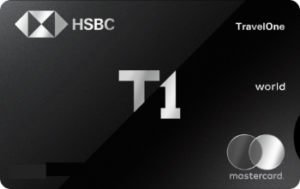

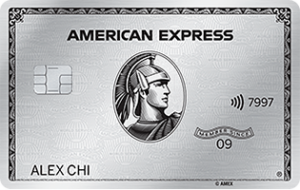
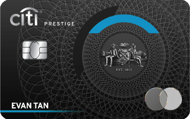



Oddly I didn’t get to choose my meal in advance even for business class from SIN to HK. Maybe they only offer it to long haul flights
Yea confirmed, I did 6 flights over last year and early this year between SIN and HKG, never once was it offered in business.
When i took the flight from HKG to LHR, menus, amenity kit, duvet, and Evian bottles (in bottle holder) were preset on all seats in Premium Economy.
Champagne were offered in glasses (both welcome drink and during meals) and hot towels as well during welcome and before 2nd meal service.
As you mentioned, I guess they only closed the curtains during LH flights to seperate the lavoratories.
you mean a physical menu? didn’t know CX offered those in PY, interesting. and I assume you mean prosecco not champagne. nice that they offer Evian in PY still!
Oh yes, I’m sorry my bad habit to type champagne, it was prosecco indeed.
Yup, they have a physical menu in PY Longhaul.
CX offers physical menus in Y and PY on long haul but not short haul. (As well as Haagen-Dazs in Y!)
The bins in the bathrooms have a foot pedal. You can just make it out in your photo.
thank you! have added a note on that.
For the lavatory trash bin, I think they fitted a step to open the bin flap? At least that was my experience in the Aria J toilet, not sure for PEY/Economy.
yeah i guess it’s touchless in that sense. what i meant was like some of the bins i’ve seen on a350s, where you wave your hand and it opens.
I think a pedal-bin is generally better as you know it stays open as long as you need it. The wave-style lids can sometimes close early, or stutter – time to wash hands again? From the airline’s point of view, any poor coordination from a user may end up with the FA having more clearing up to do.
it was like I was seeing the fall of the United States unfolding before my eyes
So Cathay got live TV and news channels? Good to know
It fell during the last administration when Biden was switching between senile and stupid.
Thanks for your asinine comment. 🙂
Yes.
Sports24, CNN, and BBC
> you have to contort yourself at a strange angle to egress.
Business class vocabulary despite PY seating
Cathay serves haagen daz in economy class too!
Have had it in both sin-hk and hk-sin routes
Guess their strategy is to sell PE like J of old, and J like the F of old.
And save money on less amenities for pax.
Excellent review. Very thorough. The food looks very disappointing to me. The waste disposal in the toilets IS touch-free. Simply use the foot pedal shown in your photo.
ha! indeed it is. i was hoping for that fancy motion activated model i once saw on an a350
Thank you very much for your review. I am looking at booking PE for our upcoming flight from HKG – HND. The recline is an issue with most PE cabins! Just seems like such a bad deal for anyone not in the front row. Did you sit at the very back of the PE cabin? This is where we are considering. The front rows are usually reserved until the last second unless you can recommend ways to secure this ahead of time. 🙂